How to Choose the Right Quilt Batting
This post is your one-stop-shop in finding aaaaall of the information you need to know about quilt batting. You may want to go ahead and tab it now. Oh and if you would like a sweet tutorial on how to baste a quilt, check out this post – it shows 3 different ways to baste your quilt sandwich. I'll wait....ready? Great! Let's jump in!
I’m the kind of person who goes to the toothpaste aisle of the grocery store and talks to myself for like 45 minutes, with varying degrees of hysteria. I mean, why are there so many different toothpaste options?! And what is the difference between plaque and tartar? And is there actual glitter in that one?
I feel like every toothpaste aisle needs a coach that will lead you to the perfect toothpaste for your individual dental needs. I also feel this way when picking out quilt batting. Or, I used to. But now, I’m here to be your quilt batting aisle coach, to make sure you never again become that paralyzed person talking to themselves in a craft store.
A few months ago I went on a soul-searching, quilt batting journey. I packed a small backpack, waved goodbye to my husband and walked off into the distance with a single goal in mind, "Find the perfect batting or die trying."
You May Also Like...
- Is There a Right Side to Quilt Batting?
- Quilting on a Budget with Poly-Blend Batting
- Why Wool Batting Makes the Warmest Quilts
- Why Bamboo Batting Makes the Best Summer Quilts
- Why Cotton Batting Is The Most Popular Choice For Quilters
- The Truth About Black Batting
- Fusible Batting Tape: Why You Need It and How to Use It
- Quilting Terms, Tools & Supplies
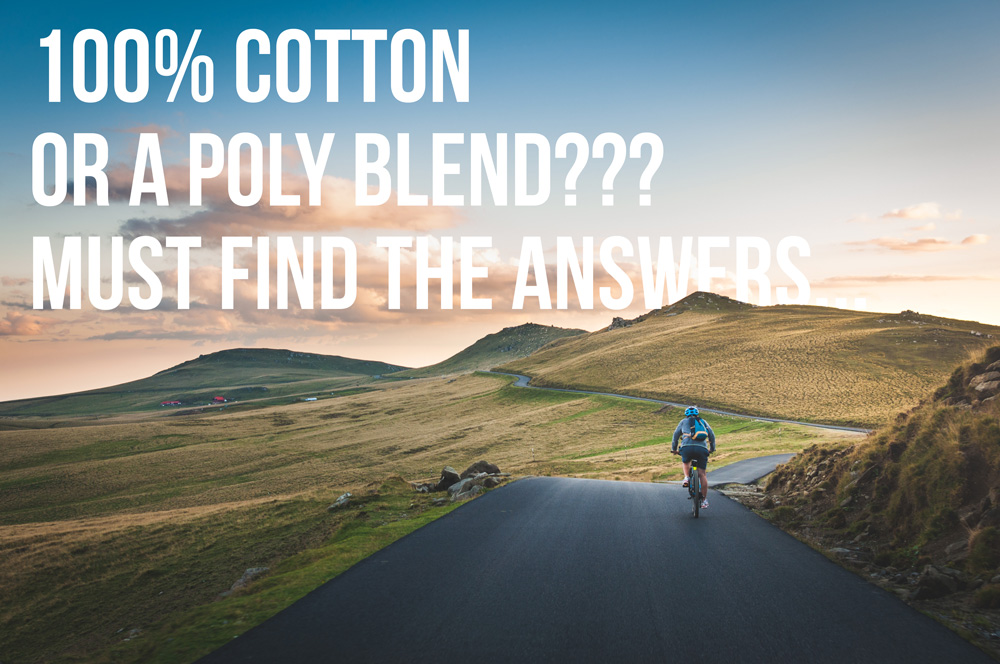
I'm happy to report that after my strenuous campaign into the cotton fields of Mississippi, through the sheep herds of New Zealand, and even deep into the bamboo forests of China, I'm back.
Trending patterns!
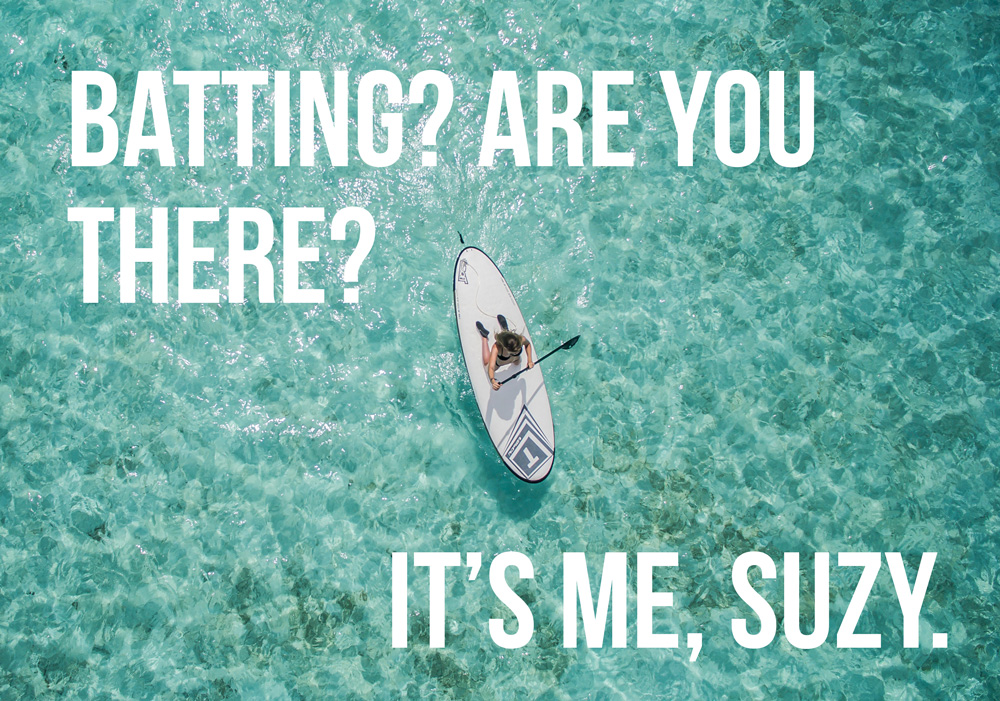
(Technically those places came to me in nicely packaged batting bundles, but MENTALLY I was traveling to all of those places.)
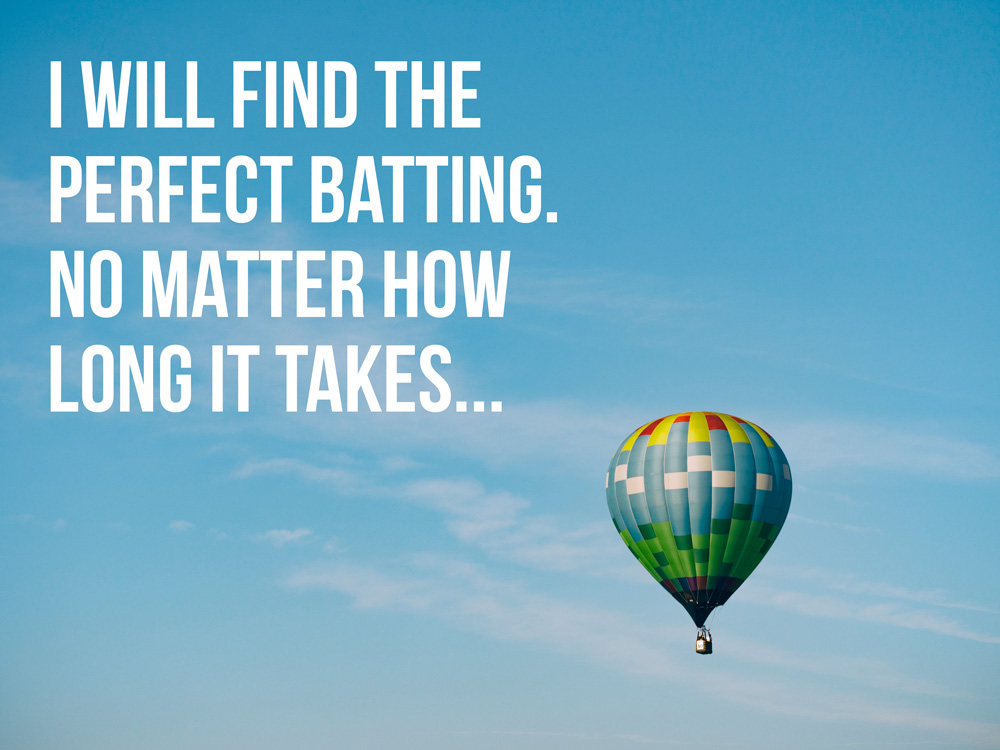
And now I'm back. With news.
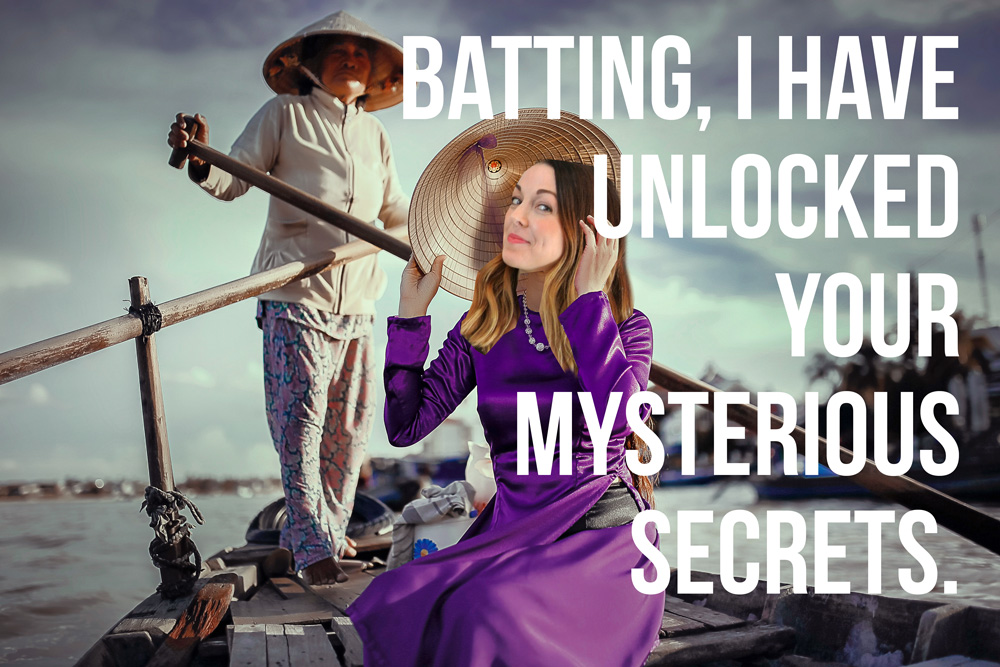
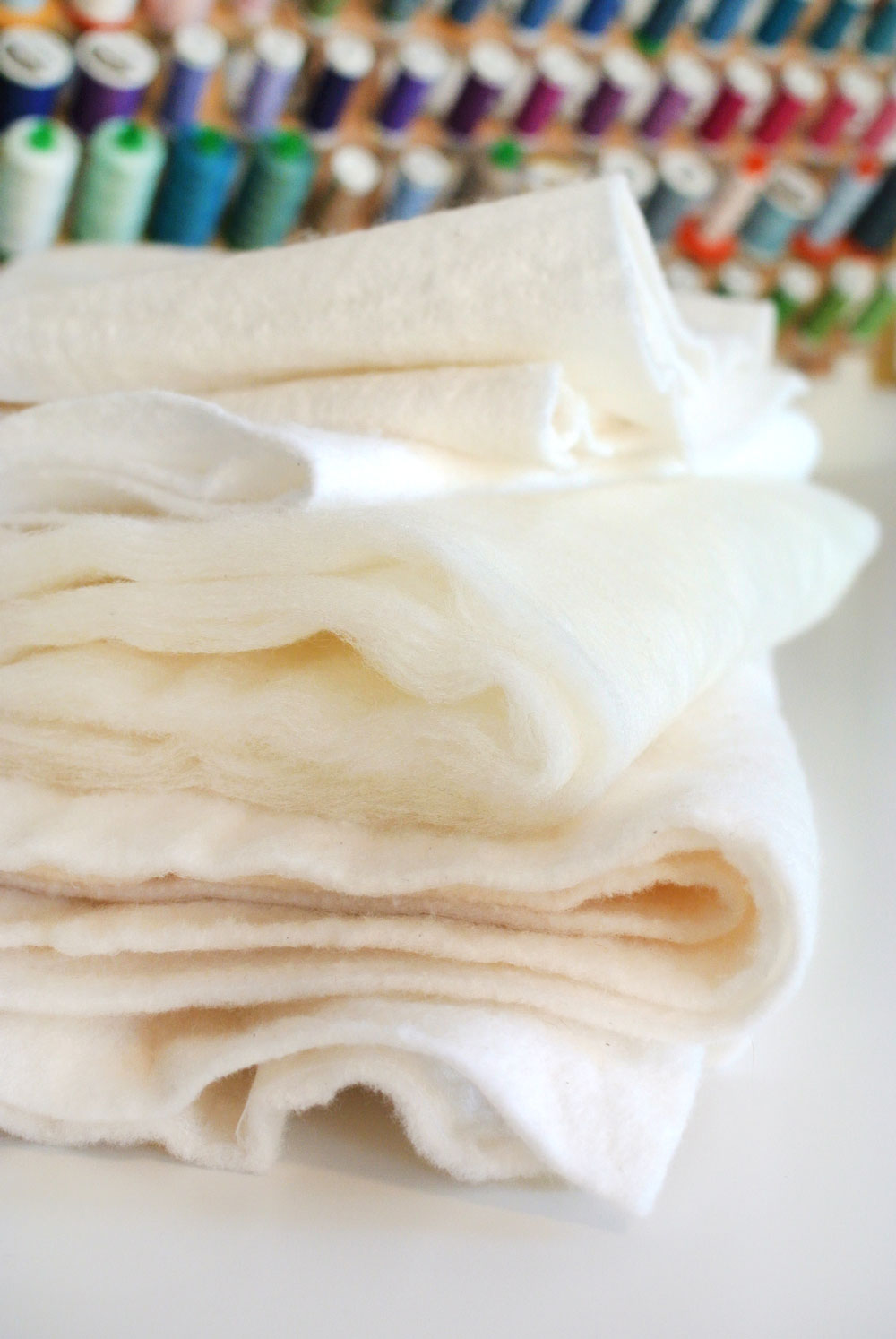
How to Choose Quilt Batting: Materials
(Quick review for the newer crowd: What is Quilt Batting? Also known as wadding, quilt batting is a layer of material used to fill quilts, giving them warmth, thickness, and weight.)
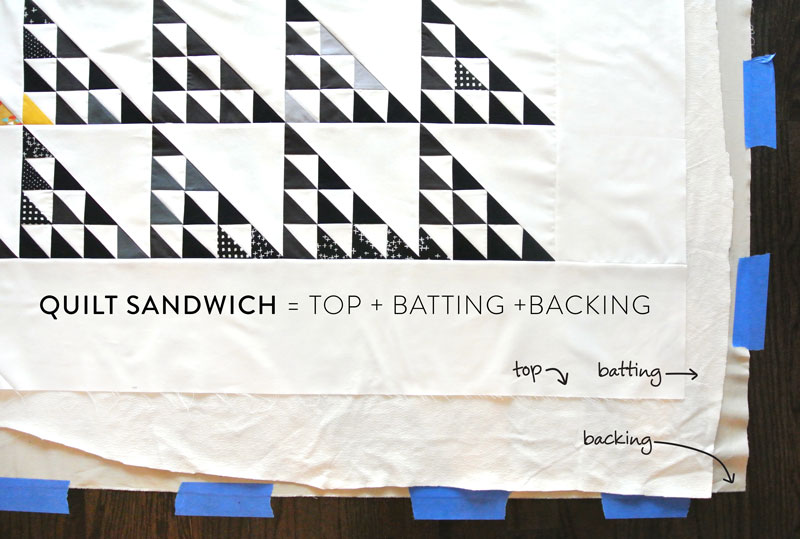
The biggest decision (and yes, I acknowledge that choosing how to finish off your quilt baby is a very big decision) comes down to material. Let’s highlight the four most common batting material choices, and what they’ve got going for them.
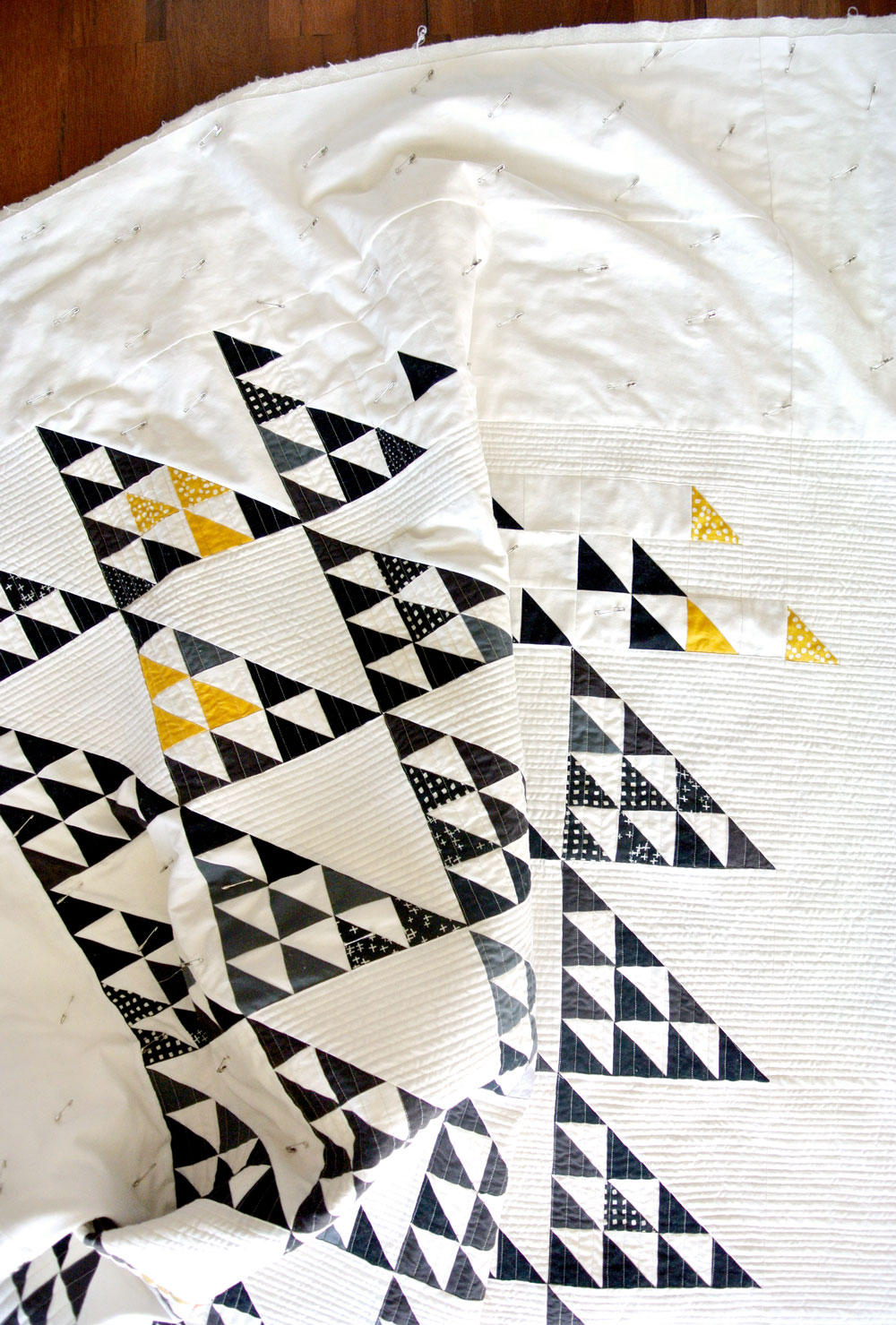
Above is the Fly Away quilt pattern. you can purchase it here in the shop!
Although cotton has a number of different sub-options, it’s a great choice for most quilting projects. Things to look for: cotton seeds in the batting. These can actually stain fabric, so beware! Cotton can also bunch after washing unless quilting lines are pretty close together. Read the package instructions to double check how closely your stitching should be.
Like all things cotton, we’re used to cotton shrinking a little bit. When inside quilts, this produces a soft, crinkly effect on your quilt surface, which some people like for comfy bedspreads, and others hate on their quilts-on-display.
The drape of a 100% cotton batting quilt is a bit stiff at first and needs lots of snuggles before loosening up.
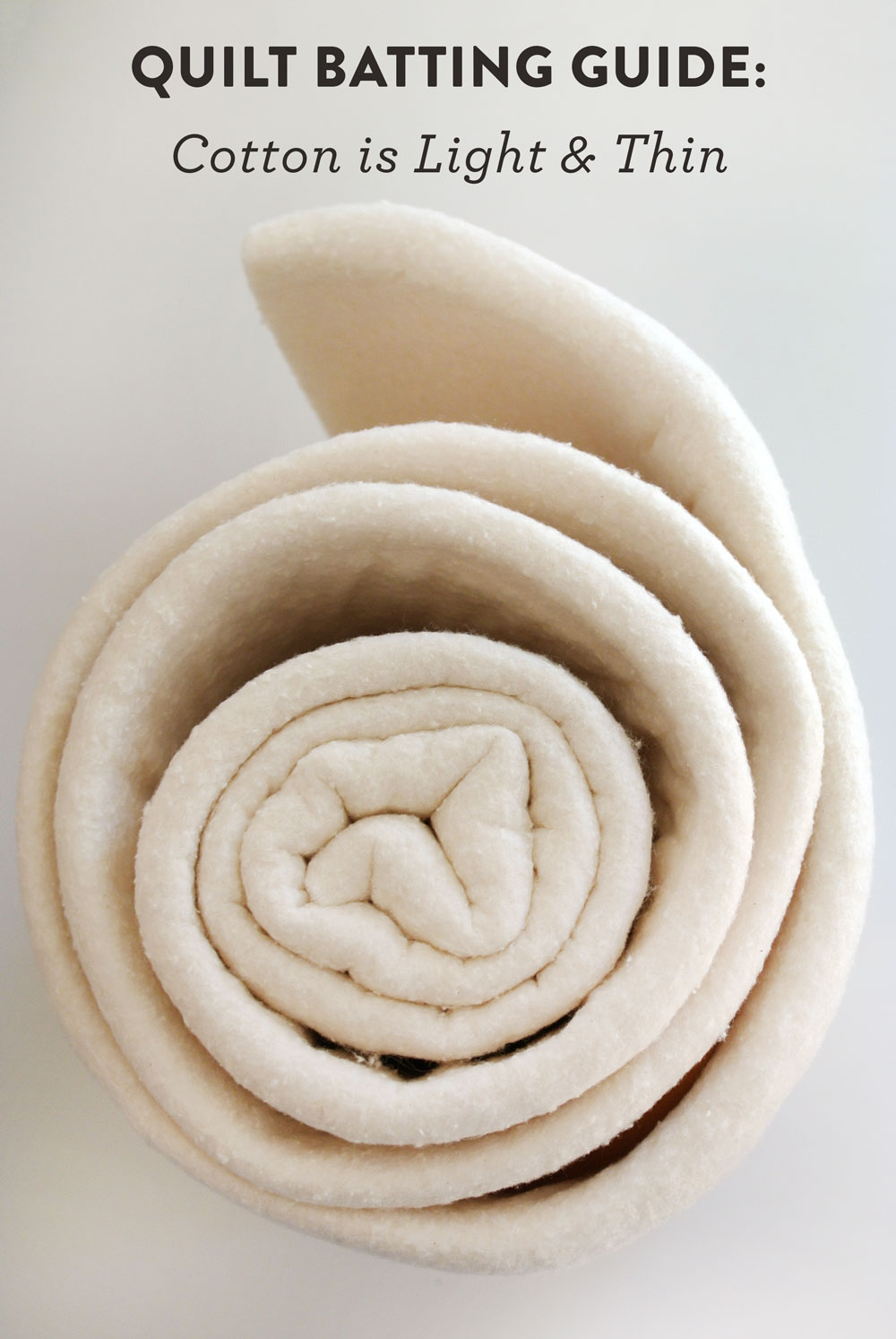
Poly Blend Batting
(Pictured below is the free Squared quilt pattern. Click here to get it!)
Quilt 1: 80/20 Hobbs Cotton Poly Blend
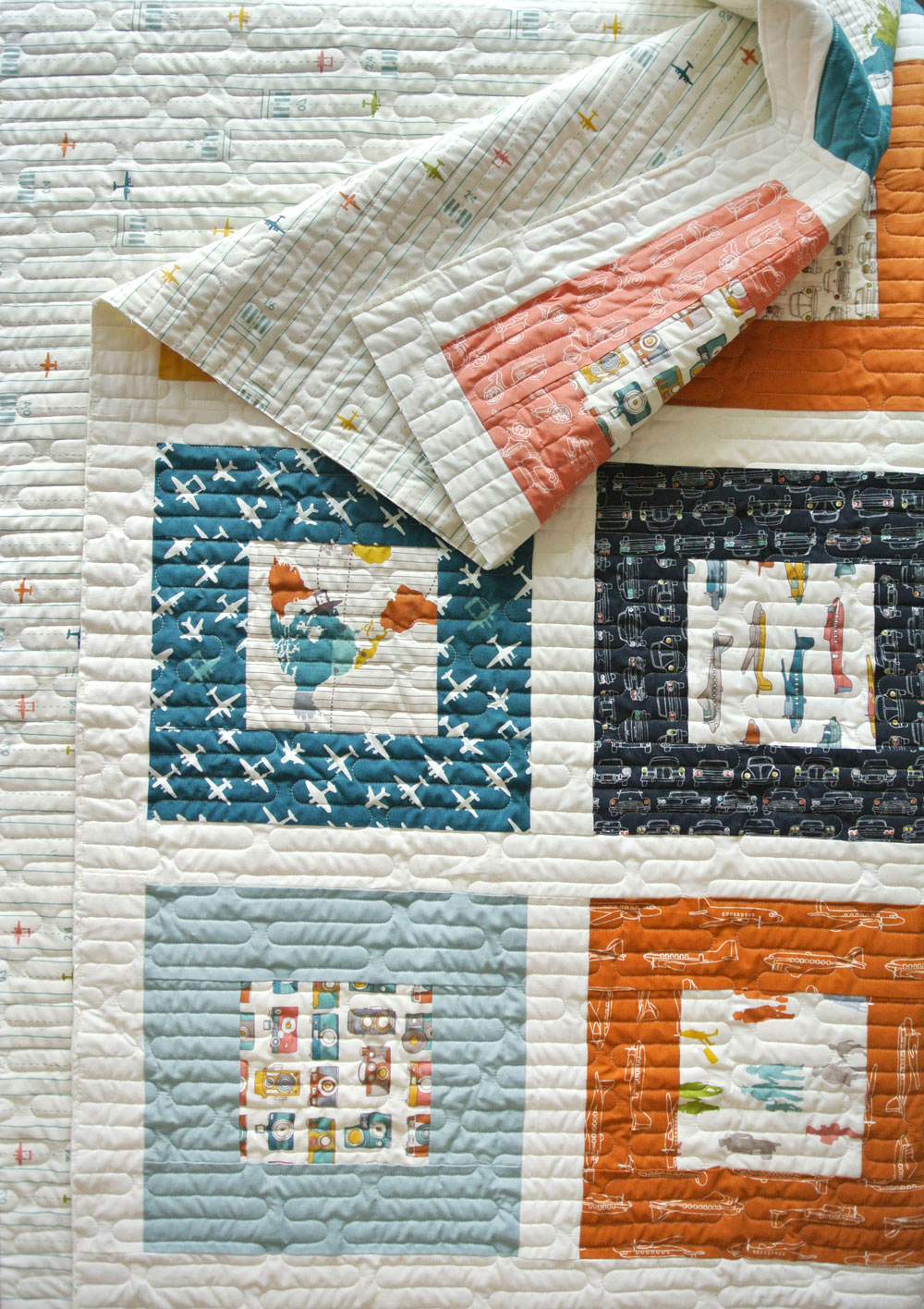
Quilt 2: 60/40 Pellon Cotton Poly Blend
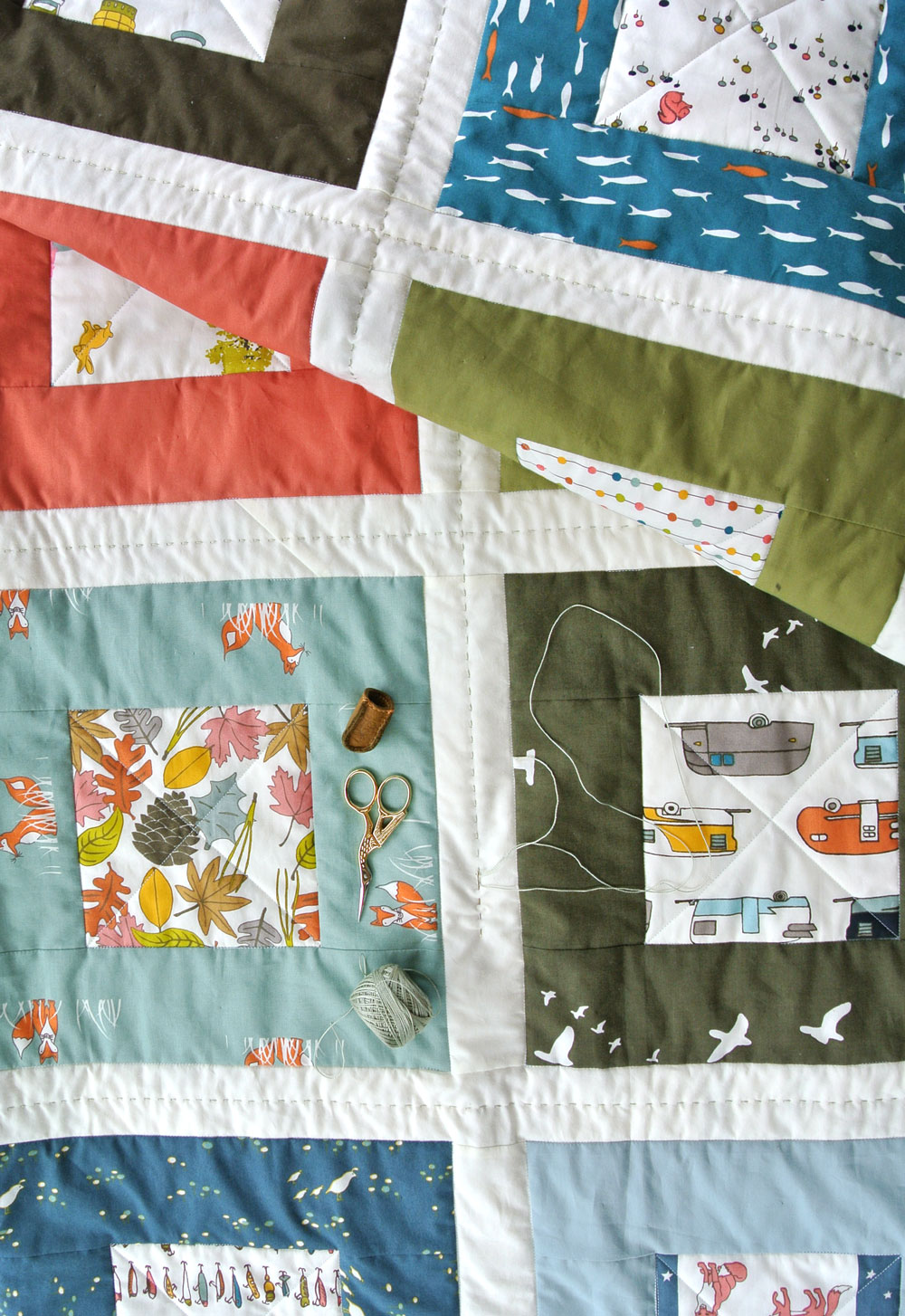
Allergies, anyone? A poly blend batting can be a great alternative to natural fibers if you’re on the sneezy side. Polyester blends also tend to cost less if you’re looking for a thrifty option. This type of batting is also easy to work with, and pretty low-maintenance. And warm. Yeah, 10 points for the poly blend!
Unlike 100% cotton batting, poly blends don't change as much in size and drape after washing. Keep in mind that not all poly blends will feel the same because the ratio of cotton to poly varies anywhere from 80/20 to 60/40.
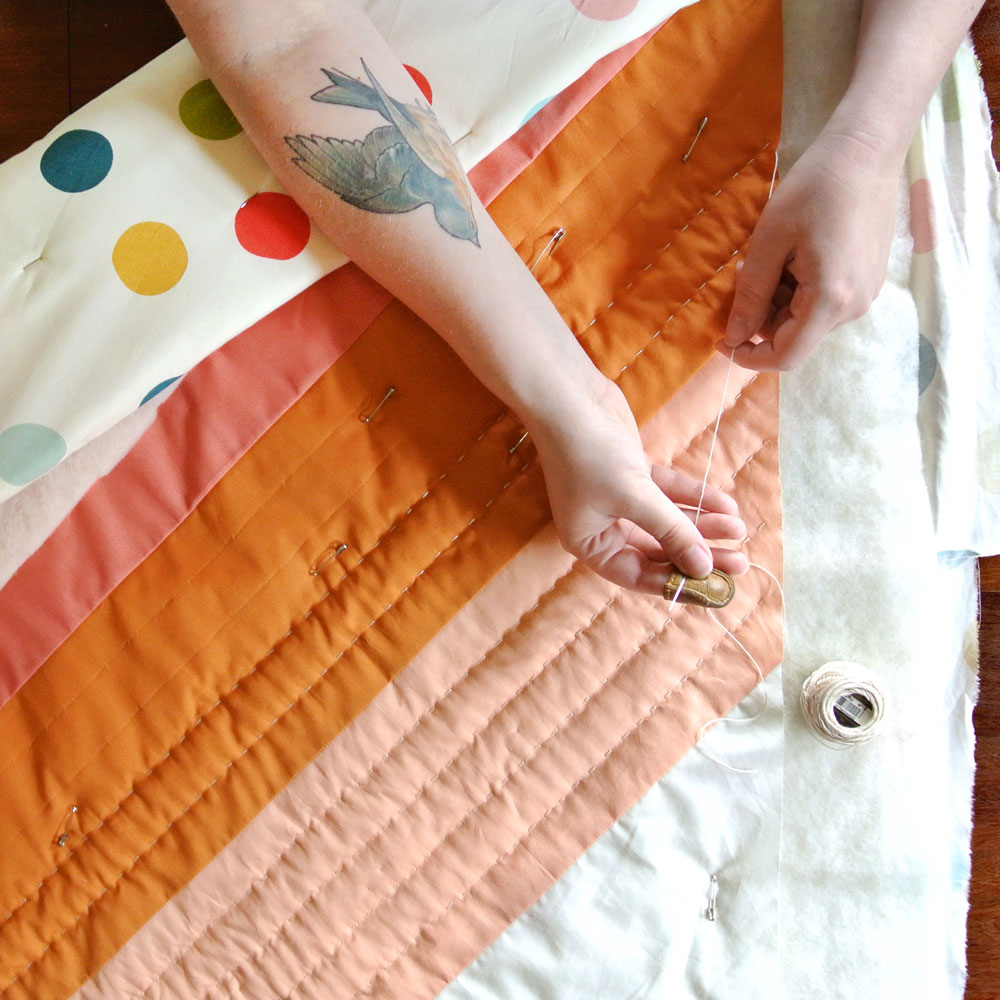
If it’s wool, you know it’s warm. It’s also veeeery fluffy and relatively easy to work with when quilting. Wool will never get fold lines or creases, even after months of being folded, which is pretty awesome for you quilters out there with stacks on stacks of quilts filling various corners of the living room.
The downside? Wool’s going to hit your wallet a little harder, and it has the tendency to beard.*
*Hold on. Beard?
You heard me right. But not the kind of beard you’re thinking of. Bearding, in the quilting world, is when fibers from the batting travel through the top of the quilt. It’s pretty common with wool batting, and basically looks like your quilt is growing a 5 o’clock shadow. So I guess it’s kind of a lot like the kind of beard you were thinking of.
The best way to avoid bearding from your wool batting is to use a sharp needle (probably fresh from the package) when quilting and piece your quilt top with tightly woven fabric. If your fabric is a loose weave or a low thread count, the wool can easily travel through it once the quilt has been washed.
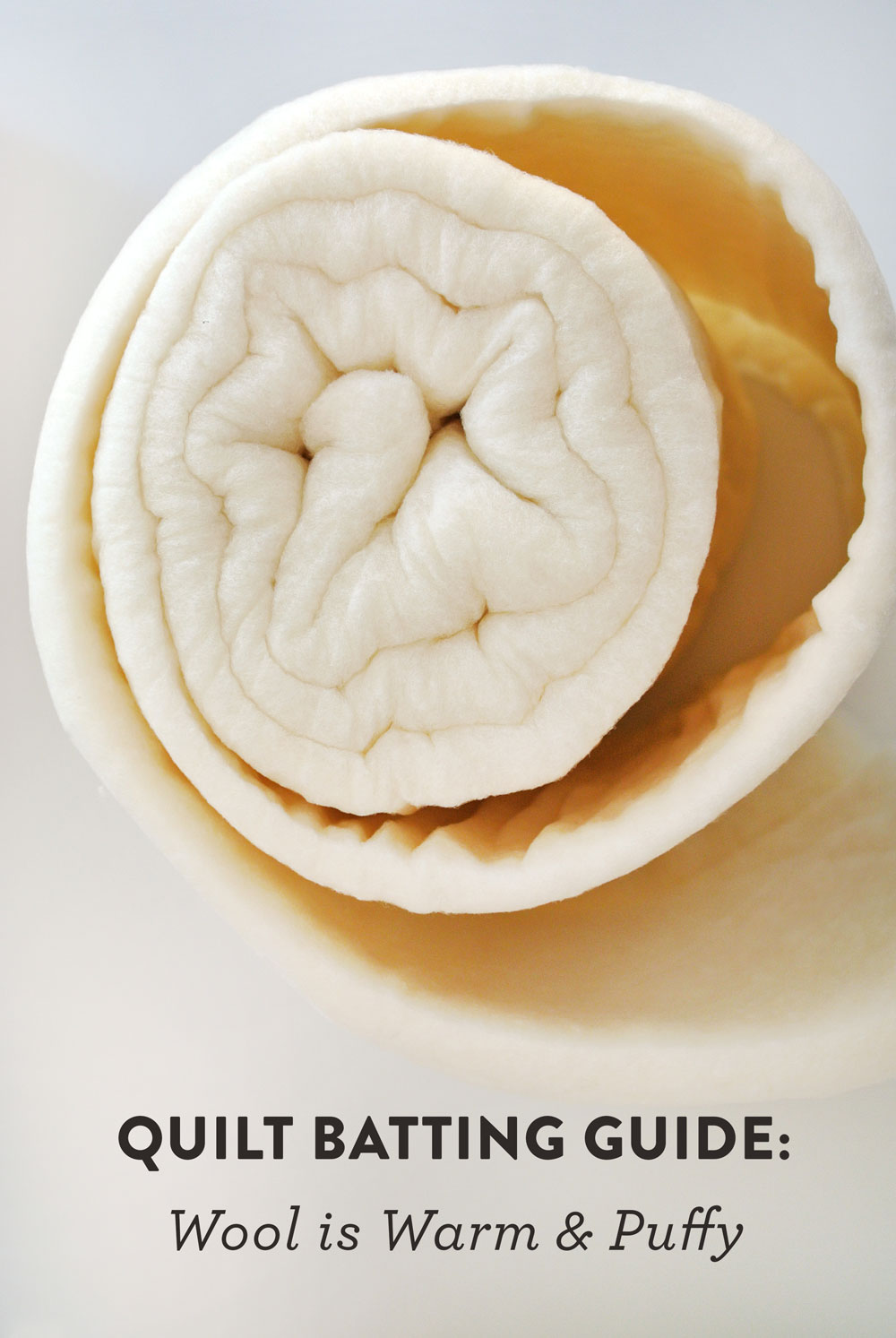
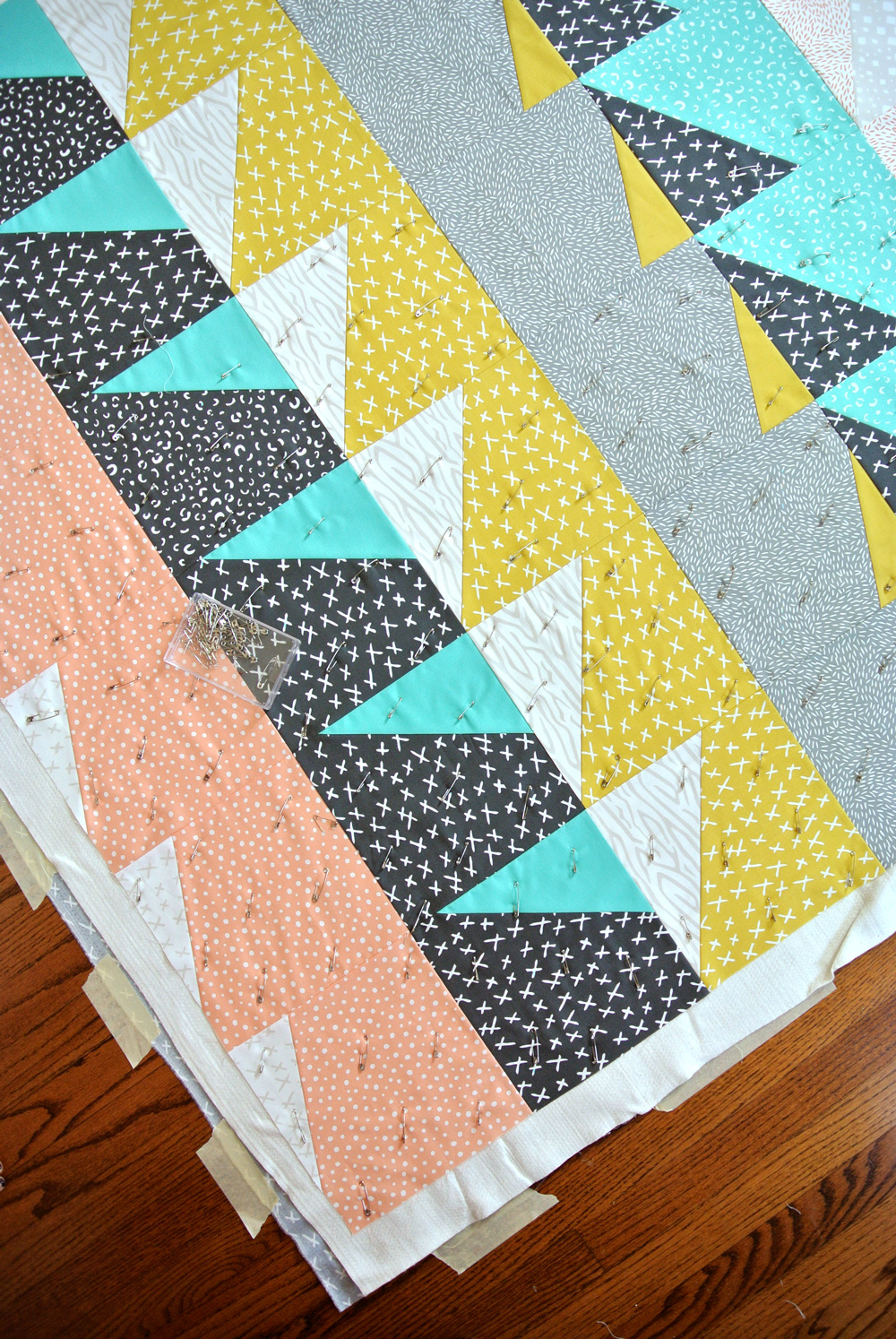
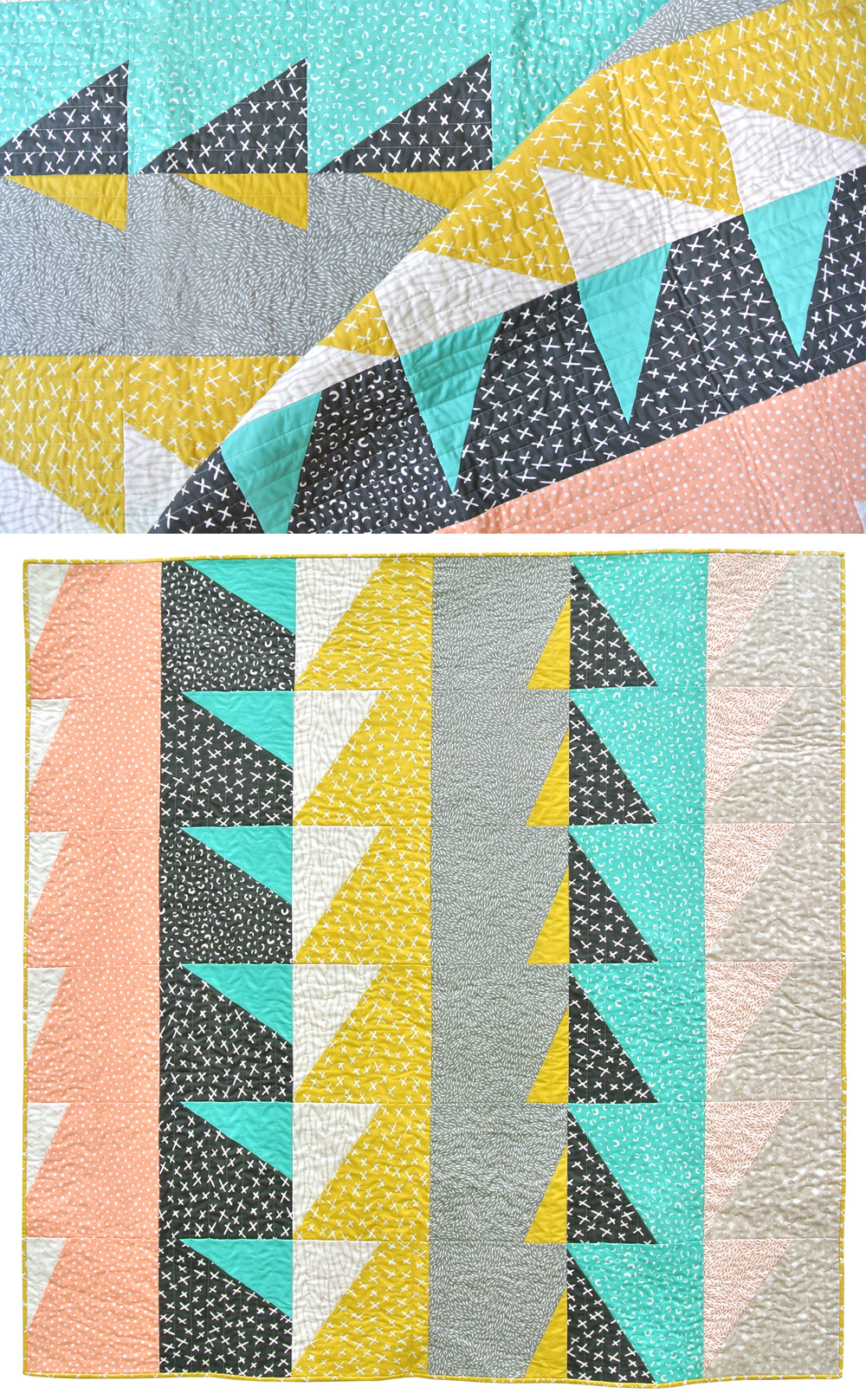
Above is the Bayside quilt pattern. you can purchase it here in the shop!
Bamboo batting is the high-end batting option… for a reason. It’s soooo soft. It drapes soooo nicely. It dries quickly after washing, and doesn’t allow mold or mildew to form. It’s amazing. It’s also expensive. Bamboo batting is a great investment if you’re working on a gorgeous, heirloom, keep-it-forever type of quilt… or if you’re just flush with cash and like soft cuddly things.
Hopefully this gives you a pretty good preview of what all these materials have to offer, and what pricing you can expect (polyester on the low end, cotton, then wool, then bamboo at the top.) The other component that is going to affect the cost is which brand you choose. Oh, you’re wondering if I have any opinions about that? Muhahahaha!
Of course I do!
How to Choose Quilt Batting: Brands
The material you use is a big divider when you’re looking at utility, but which brand you choose will have a legit affect on the longevity and overall quality of your quilt. I have a few brands I use regularly and recommend. Here are the three brands that get the Suzy Stamp of Approval:
Quilter's Dream
During my long and grueling quest to find the perfect batting, I met a spiritual guide...through a dream. A Quilter's Dream. And what a wonderful dream it was!
Quilter’s Dream batting is everything batting should be; consisting of high quality materials with soft and silky fibers. Quilter’s Dream offers cotton, poly blends, wool, bamboo, and even an earth-friendly option made out of recycled plastic bottles! I love all of the options, and I love that I know I can count on all of them being well-made.
Pellon
For those who like to shop online or only have access to big craft shops – this stuff is very easy to come by. I've tried all of the big box store brands, and Pellon is where I keep coming back.
Pellon also offers all four major batting material options, and is a standard go-to batting brand for a lot of beginners and experienced quilters alike. I would recommend Pellon for both machine and hand quilting, Pellon’s cotton batting is also ultra-clean, so you won’t have to worry about those pesky cotton seeds I mentioned earlier. (And trust me, there are few things as frustrating as finishing a quilt only to notice that you can see a 1/4" black dot UNDERNEATH your white fabric. It looks like a terrible stain you can't scrub out.)
Hobbs
Hobbs is another well-known, top-quality brand that pretty much offers every different kind of batting option out there. Many quilters I know are all about Hobbs Heirloom wool when they go the wool route, and though it’s on the more expensive side, it’s so reliable, and drapes really well.
But What's the Right Quilt Batting: One Quilter's Opinion
When choosing the best quilt batting for your project, there are a few other things to keep in mind:
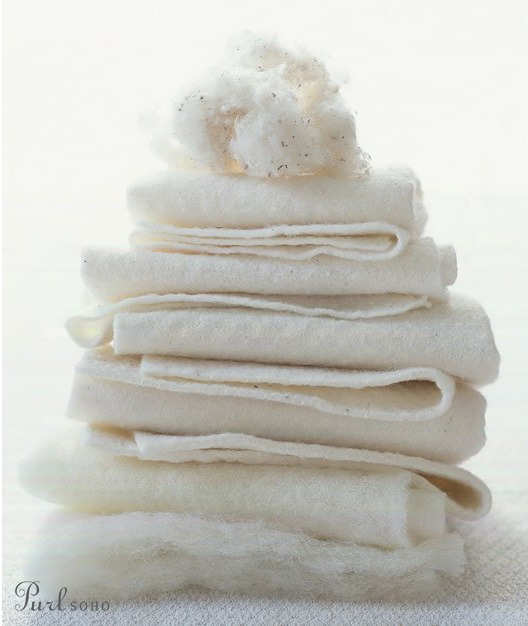
Go for “white” over “natural.” Now, this may be a more personal preference, but I always go for white batting because of the darker flecks found in “natural” cotton. Sometimes, these flecks can show through light-colored fabric, and with the crazy amount of white I use in my quilts, I have a strict “No Flecks Allowed” policy.
Know the Skinny on Scrim. Some batting comes with “scrim,” which is a thin layer of stabilizer that gives your batting some strength, and keeps fibers from escaping and creating that dreaded beard. If you decide to go with a batting with scrim, it’s best to face it toward the back of your project. (You'll be able to feel the difference.)
Don't Get Too Lofty. One other term you should know when checking out batting is “loft.” Loft basically refers to how thick or fluffy your batting is, with lower loft being thinner. Low loft batting is great for a flatter finish, where you want to show off your piecing more than your quilting lines (though if you are hand quilting, choose low loft no matter how amazing your stitches are… it’s just easier.) Go for higher loft if you want a nice, puffy quilt with very visible quilting lines. However, keep in mind that if you get a high-loft batting it can look a bit dated – member those puffy Care Bear quilts from the 80s?
Sometimes, it takes some experimentation to really get the hang of choosing batting (anyone have some weird batting results they want to share??) but know that you’re not alone! Next time you’re having a panic attack in the batting aisle, hit me up 🙂
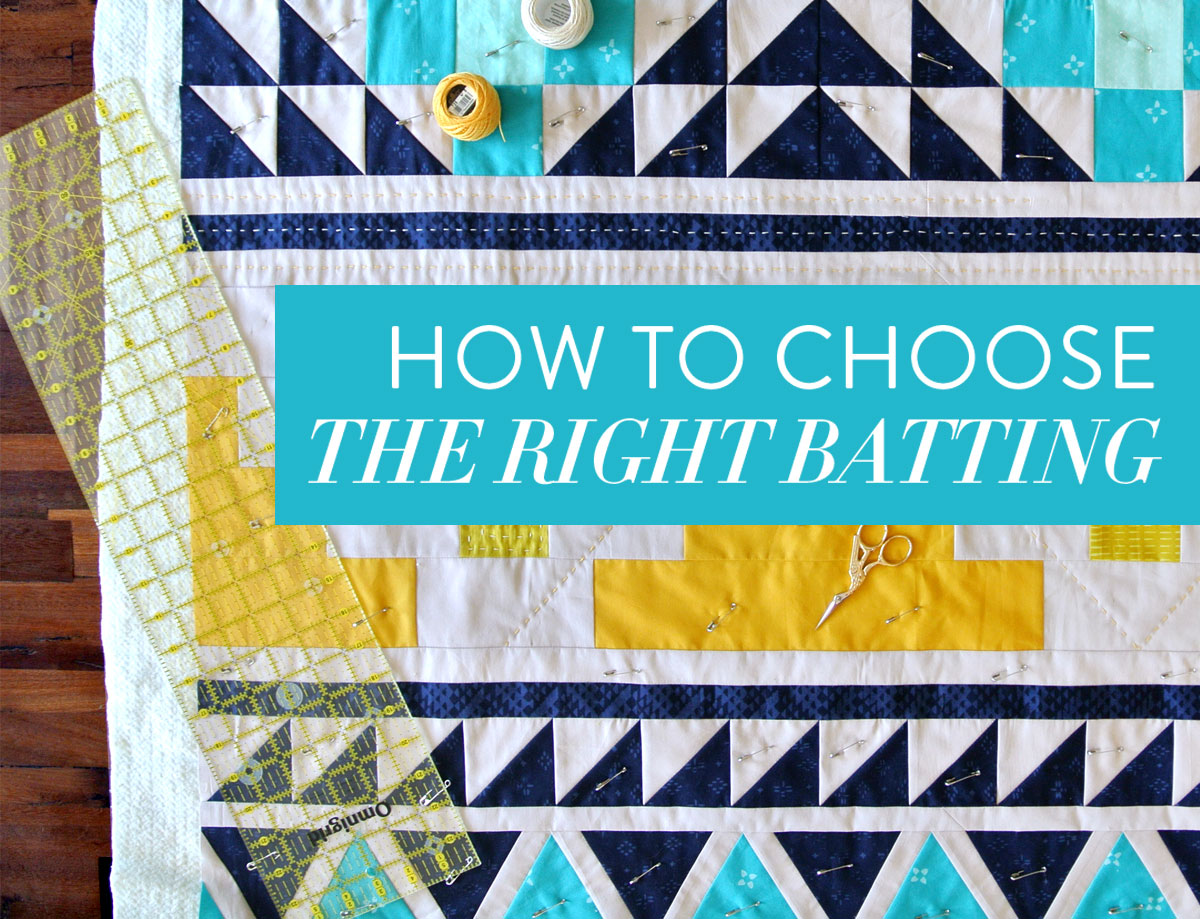
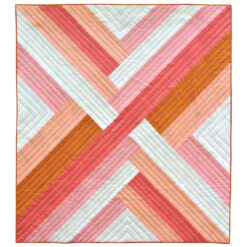
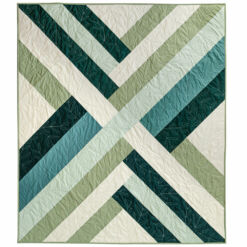
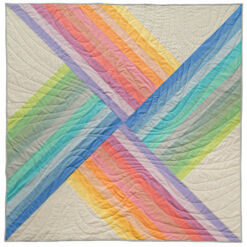
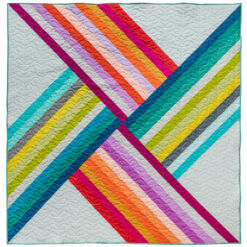
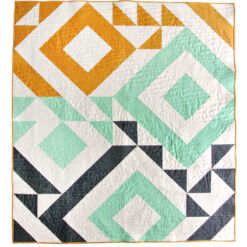
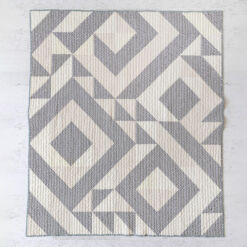
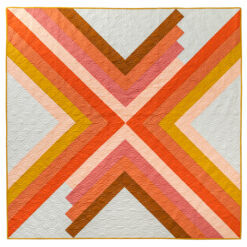
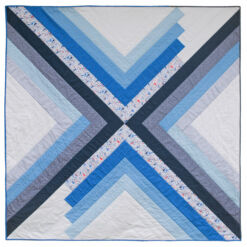
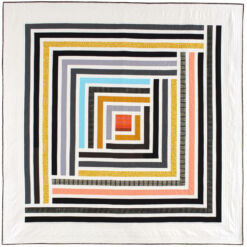
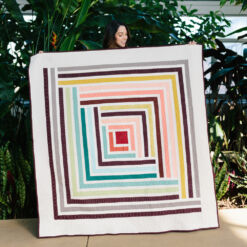
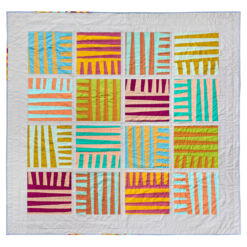
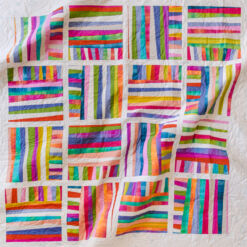
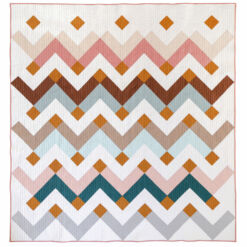
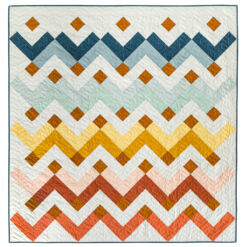
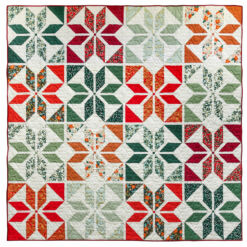
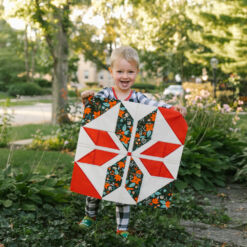
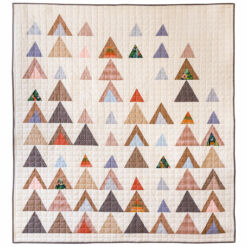
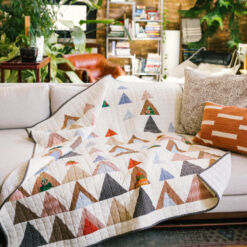

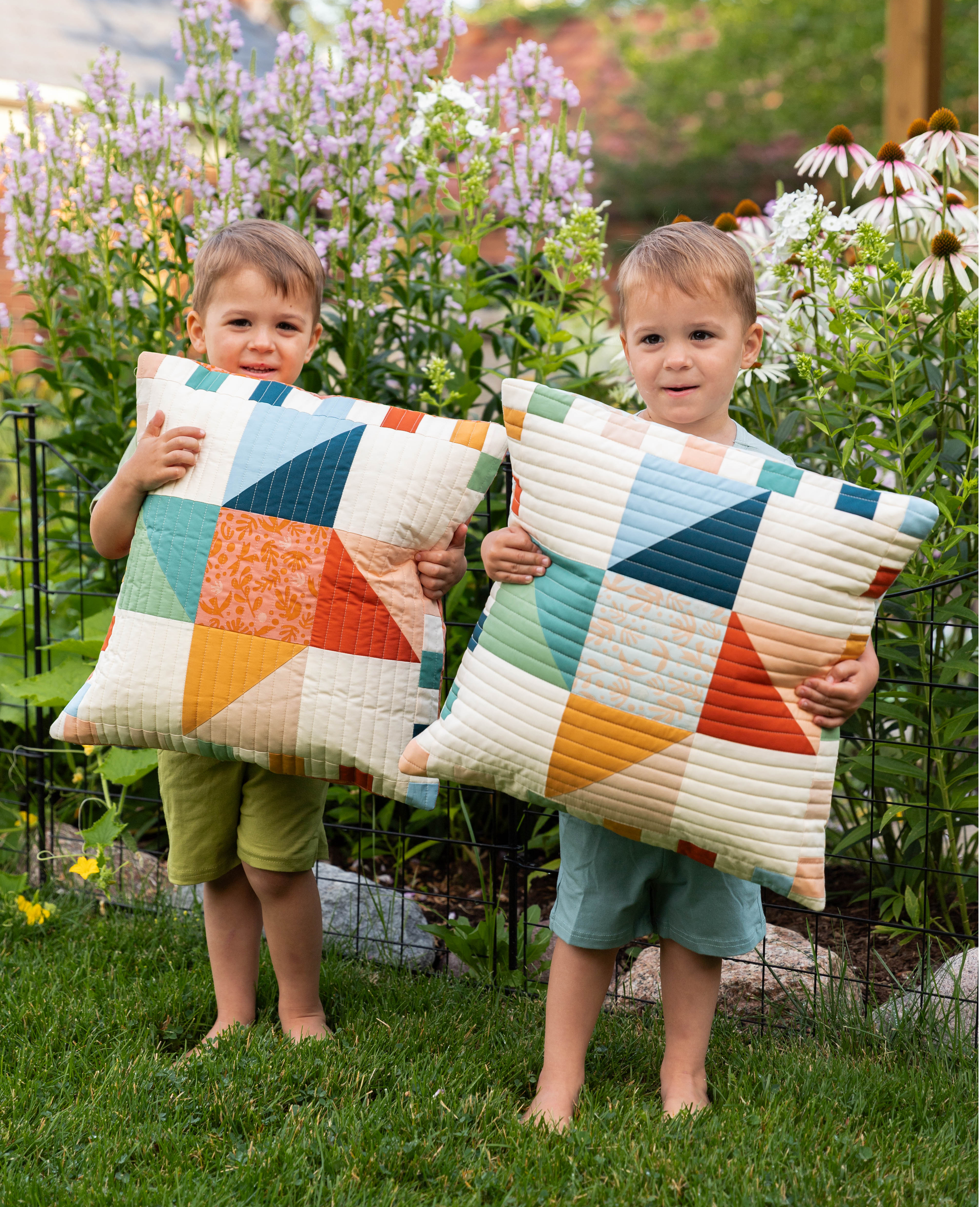

I’ve only used cotton and poly-cotton but I was surprised when I used the poly cotton that the quilting had to be a lot closer. I like being able to do loose quilting sometimes! And also now I feel like I can only use bamboo batting forever…hmmm…
I am finishing my first quilt ever for my hubby for Christmas. He likes soft puffy quilts that aren’t too hot or heavy. I’ll be tying the quilt with my grandma so am hoping for something ok with a 9″ quilting distance. I ordered the Pellon Quilter’s Dream X (one sided fusible batting) thinking it would fit the bill but now I’m having doubts. Is there a better batting I could use? Hoping for fusible since I’m new to sewing, I’m thinking it will help reinforce my seams plus the less layers to deal with while trying the better! Thanks!
Suz, did I miss it?! Did you mention which one is your fav?
Tutti girl, you missed nothing. I was very sneaky and intentional about not sharing a favorite. The truth is, sometimes it’s nice to switch it up! My favorite brands will probably remain Quilter’s Dream and Pellon, but within those brands, I will hop around among all of the options.
Hi Suzy, I am making your Indian summer quilt pattern for my granddaughter. I had to improvise because I am making it as a twin size. She will be using when she moves to a twin size bed as she is just turning three. I plan to straight line quilt. I will go with Quilter’s Dream or Pellon. Would you use all cotton or a poly blend? or do you have other recommendations? I have only used warm and natural cotton for the two other quilts I have made.
Either batting would be a great choice. A poly blend will be a lighter quilt than the cotton.
What is the quilt pattern just under heading of 100% cotton batting. The flying geese triangles? I really like it & the article is so informative. Thank you
It’s the Fly Away pattern. You can purchase it here – https://suzyquilts.com/shop/fly-away-quilt-pattern-download/
I’ve made a few quilts before but I learned so much from this site. Things I never knew,before. Thank you!
Making a reverse denim quilt for the first time. What is a good batting for this? Thank you
I’m not totally sure what a reverse denim quilt is. Will you just be using the back side of the fabric? Since denim can be heavy, a light batting would work great. I think bamboo is a wonderful option!
Your quilts are beautiful. I use Accuquilt for my cutting and most patterns, since I am not good at translating the blocks and sizes for my dies. I just stumbled upon your blog. You have great information. I think I am going to buy a clapper for my seams! I may even buy a new wool pressing mat. Mine is a little worn out.
I am making a flannel quilt (front and back ). Do I need to use batting ?
Batting will help stabilize the front and back layers as well as the pieced seams, so I would recommend it.
very informative. I usually use a cotton 80/20 with scrim as that only needs quilting every 10″ and the quilting part is so very hard for me to do. Having to quilt so close is not the way forward for me! I did do a charity quilt a couple of weeks ago batting and backing provided along with the flimsy and that was a polyester one, I found that better to work with than I thought it wold be
Great post! I’ve only ever used 100% cotton, but the bamboo sounds really really nice! I think I want to do my next quilt on a longarm and I’ve seen some people do two layers of batting to get the quilting to really “pop”. Have you ever done this? I’m tempted… but I don’t want to ruin it! Lol
I have never done that, but I doubt it would ruin the quilt. It may make it really stiff, but eventually, it would loosen up. If you haven’t tried wool batting yet, I suggest trying that before double layering. Good luck!
I love Quilters Dream Wool Batting ❤️ It is warm in the winter but also so lightweight and cool for summer…My go to batting!!
Good job describing each type of batting Suzy! After working in a quilt shop for years it’s still the one isle that people definitely struggle in😉
I use two layers of warm and white batting all the time in my quilts. I have no problems with quilting this batting on my domestic machine. Just set your tension to get good stitches, and adjust the presser foot pressure if needed. After washing, you have a substantial, but flexible quilt that gets more and more cuddly with repeat washing, even if densely quilted. Good luck!
Choosing batting is such a weird mystery to me, so thank you for this! I always tend to like my quilts to be as drapey and floppy and non-stiff as possible. Do you find cotton of poly-cotton to be more drapey/less stiff? I’ll have to give bamboo batting a try sometime… that sounds awesome!
I have found cotton poly blends to have a floppier drape straight off the sewing machine. 100% cotton batting is a bit stiffer and needs to either be washed or used a lot before it’s drape mimics the cotton poly.
I always wondered why my quilts were stiff. New quilter here. Most informative article.
For those who use wool batting, can those quilts be washed?
Yes, ma’am! https://suzyquilts.com/why-wool-batting-makes-the-warmest-quilts/
I was gifted a quilt with wool batting. It smells when i wash it. That right there would stop my from using it on quilts i am gifting to others.
I have a weird batting story… I finished a quilt recently that I started over ten years ago when I was young and had no idea I was using too many colours. When I found the top and got to finishing it, I really didn’t want to put any more money into it. So for batting I used polar fleece! Not even one piece! I sewed two different colors together! So now the whole quilt is weird, the top that I made when I was young and silly, and the finishing when I was older and still silly.
That sounds weirdly AWESOME! Originally, quiltmakers would use all sorts of random materials to fill their quilts. I’d say that you were just getting in touch with your inner quilt historian. 🙂
I know this is an old post, but what you said about what they used to use reminded me.
I bought an old ‘puffy’ quilt and I opened one of the puffs and they are filled with silk stockings. Not pantyhose, just silk (or maybe nylon), thigh high stockings. Very heavy and completely cool!
WOW! That’s so cool!
This brought back a memory of when I was in high school (decades ago) and making stuffed animals. Not all of us were rich enough or stylish enough to have hosery for daily wear. So I had a “supplier” who would give me her old pantyhose that had runners to use as stuffing.
BTW – just found your blog, Suzy, and LOVE all the tips!
Oh my goodness – my mum was a seamstress and used to make stuffed animals for presents. Everyone in the neighbourhood used to give her their stockings with runs in and I would spend hours shredding them for stuffing (also decades ago). And I thought I was alone …..
Hi Suzy, I love your information. Have you ever made a baby or throw quilt and used flannel instead of batting? I have been making scrap quilts as gifts and wanting to reduce the cost, and be slightly ‘authentic’ to original quilting, have been finding king size flannel sheets barely used at thrift stores. The result is a thinner quilt. I don’t know how it wears over time since I have given them all as gifts. I’d love to know if others have tried this or anything similar to make a true ‘scrap’ quilt. Many thanks.
Using flannel as a substitute for batting is a fantastic idea––and, like you said, more authentic to traditional American patchwork. Large pieces of flannel would be quite durable and should hold up over time just as regular batting. You can read more about flannel here – https://suzyquilts.com/quilting-flannel-tips-trade/
I make baby quilts for NICU babies to cover the isolete. I use black flannel (prewashed) for batting. This is mandatory to keep the light from getting in the babies eyes and to help keep the heat in.
Too many colors? Check out Kaffee Fasset quilts! It’s a color riot and just fantastic!!
I think I bought 100% poly batting high loft. I like the puff but I don’t have enough experience to know when to use it. I am making a baby blanket 36 x 36 and I was going to use it. The machine I am using is a long arm Pro Sticher in the bubbles pattern. Will that look okay? I don’t like all the puckering once you wash cotton batting quits
If you don’t like puckering be sure to pre-wash your fabric and also think about using poly thread or a poly thread blend. Even cotton thread can cause a quilt to shrink a little bit when washed. I think that quilting design will look great!
Suzy,
I have read this before, but went back and read it again. Thanks for all your kind help! I’m just about to order some batting!!
I have used both Hobbs and Quilters’ Dream wool batting and would rate them excellent.
I have used the Hobbs Silk/poly blend-lovely -and the QD bamboo, sooo soft, both
a bit expensive. I make bed quilts and mostly use Quilters’ Dream Select, a mid loft all cotton
batting. As I longarm quilt for others I get pretty much everything to work on. I dont’ like
the high lofts on a longarm – I’m sure is fine for a tied super puffy look.
Great info! Thanks for the comment, Sally.
Just learning to hand quilt. What is the very thinnest (lowest loft) batting?
The thinnest? hmmm…probably bamboo. Quilters Dream has a wonderful bamboo blend batting.
Which batting is the coolest? Thanks for the info!
I think bamboo batting is what you’re looking for – https://suzyquilts.com/why-bamboo-batting-makes-the-perfect-summer-quilt/ 😉
Hey Sally which do you like best the hobbs silk or the QD bamboo?
Great info – Thanks so much for the post! Did I miss the Warm and Natural? Did you not include it because it is not top quality?
I would put Warm & Natural in the same category as Pellon in terms of availability and price. Personally, I think Pellon is better quality and never has those terrible dark flecks that drive me bananas.
This is super helpful – and might get me to try a bamboo or wool in the future. On a similar note, what are your thoughts on spray basting? I had always pin basted until a couple weeks ago, when I tried spray basting. Long story short, it did not go well, even after I watched PLENTY of youtube tutorials. Any advice?
I’ve spray basted in the past and have found pin basting to be the better option. Here are my reasons: 1. Spray basting was making a mess in my house. No matter how neat I was, that sticky spray would get on my floors, walls, and furniture. yuck. 2. That stuff is expensive! Pins are a one-time investment. 3. Safety pins don’t shift. When I spray basted anything larger than a baby quilt, my quilt sandwich would shift and get all out of wack.
I don’t like spray basting at all! It is bad for your lungs and the environment, it leaves a sticky residue on your quilt, too. Even the directions on 505 say ‘to remove adhesive – dry clean’. No thank you, I ♥ my curved safety pins and I can remove them without professional help lol.
I didn’t know about the dry cleaning! All the more reason to not spray baste 😉
I have used spray basting on two of my quilts. It washed out completely on the first wash.
How about silk batting? I’ve recently seen some of it and it is beautiful but where would it fall in your list?
The existence of silk batting is news to me! I will try to find some and report back. 🙂
Thank you Suzy! Great job wandering the batty world! I concur with QD and Hobbs, though I’ve never used the Pellon. – Jean
I usually use 80/20 because it doesn’t stretch or get misshapen like cotton can tend to. But another dreamy option is silk! Silk batting in a lawn or voile quilt is like the lightest, drapieat quilt ever.
woooow!!! Ship me some of that! I’ve never tried silk, but now it’s at the top of my to-do list.
I love the Tuscany silk by Hobbs. Do itttt!
Hi! I know I’m 6 years late to the post, but was wondering Suzy, if you’ve tried silk batting yet?! And if so, thoughts? Recommendations? Really appreciate your blog and all the great info!!
I love using Quilters Dream Bamboo/Silk blend. I have not tried pure silk batting, but I can say the silk blend is wonderfully soft and has a lovely drape. For more on that check out this post – https://suzyquilts.com/why-bamboo-batting-makes-the-perfect-summer-quilt/
Regarding loft, when I started Quilting 20 years ago I remember 1/4 inch loft was desirable and easily available. Recently I was shopping for batting in brick and mortar stores and a majority of batting was 1/8 inch loft. What happened? I longarm quilts, the 1/8 is too thin, a piece of flannel would do as well. The experience left me disappointed and a little bit frustrated. Am I alone?
You’re definitely not alone. I have found it common for cotton batting, specifically, to be thinner and denser than it used to be. If you are looking for a batting that is closer to 1/4″ in thickness, you will have to shop “deluxe.” Try out Quilter’s Dream 100% Pure Cotton Supreme if you haven’t already.
I tried the Quilters dream wool and it started bearding heavily as soon as I started quilting it. Is there a way to minimize the bearding? In your experience which one beards the least of the wool batting?
You are seriously one funny lady. I will continue to stalk you.
Also, if x + 1 = 3, what does x equal? Darn algebraic robot checkers…
Hi, my husband and I are in the process of house hunting for the perfect acreage. My big dream is to raise alpacas and make quilt batting from their fleece. Were we live right now there is a place that will process alpaca fiber (75% alpaca, 25% wool) into batting for an astonishingly reasonable price. In your pilgrimage of finding batting…did you come across alpaca fiber batting? Any thoughts on that type of batting? My understanding is that it is lighter, warmer, and contains less lanolin than wool and easy to quilt/work with.
I am unfamiliar with alpaca batting, but would be the first to jump on board if I knew where to get it! Let me know if you start producing it. Sounds super dreamy. 🙂
I have used alpaca and it is wonderful. It is lighter yet warmer than wool and most people who are allergic to wool are NOT allergic to alpaca. It’s pricy but I think it’s worth it in some cases (like baby quilts).
https://www.etsy.com/listing/454183616/alpaca-quilt-batting-all-natura-crib?&utm_source=google&utm_medium=cpc&utm_campaign=shopping_us_a-craft_supplies_and_tools-yarn_and_fiber-stuffing_batting_and_filling&utm_custom1=640cfd16-3789-4285-96b8-997132b312c8&gclid=Cj0KCQjw5arMBRDzARIsAAqmJexByWvzOprIU1lx9djPCXxYk335qKUqfBoCpMYffPb8UGJfonM6p2caAqKwEALw_wcB
Do you have any thoughts on fusible batting?
I’ve tried it, and messed it completely up. Typically fusible batting is only activated by steam – which means that I was on my hands and knees trying to steam iron a quilt while it was on the floor. The process was miserable, not to mention that I bunched up both the backing and the quilt top. In the end, I ripped all of the layers apart and pin basted it. I’d be curious to hear a success story about fusible batting…
I used fusible batting on my first quilt, a bedspread sized beast for my son. Putting the quilt sandwich together turned out well but was no fun – yes down on my knees on the floor. I hand quilted it for about three years then got impatient and asked a friend to longarm it. She tried. The thread kept breaking so she handed it back to me. Even hand quilting I could only use short pieces of thread because of breakage. I finally finished it before my son graduated from high school. To top that off, when I finished, I washed it to get the adhesive out and the thing started bearding. Don’t touch that stuff.
I’ve used it when making fabric panel books. There it is fine.
Fusible batting is ok for things like placemats, oven mitts and smaller items, and it can be especially helpful for small items where you don’t really want to pin such small items like coasters for example. Fusible batting is typically used for making a quilted purse or bags where you want the item to have rather hard surface with some cushions, and it has its own place in batting and interfaces in sewing world. It’s not the steam that activates the “glue” (it is not really glue but these days it contains resin which gets activated via high heat, not steam). It depends on the fusible batting you use, but typically it is not recommended to use any steam as usually the instruction says so (and this is same for making clothes when you need to use some fusible interfaces for neck line etc.) When you are ironing, you should not be moving your iron like regular iron like gliding the fabric but you just need to leave the iron on for 20 sec. or so in one place, then move the iron to a new area and leave it and forget it for 20 sec. or so. and continue on until all the surfaces are ironed on (heat fused). It is a lot of work normally, so this is not usually recommended for such huge areas like bed sized quilts, etc. as it usually makes stiffer surface, which is more ideal for pot holder, oven mitts, placemats, table runner etc. And normally you should use another clothes on between the fabric you’re ironing and the iron, as it will ruin your iron if you don’t.
Very useful info. Thanks! Do you have a recommendation on what kind of batting to use for tablecloths or placemats, since they have to be washed more frequently? I once heard someone that said she used flannel as batting, but I thought flannel shrinked a lot. Thank you for your advise.
Great question! Flannel won’t be any sturdier than 100% cotton batting, however it will be a lot thinner. I have used both 100% cotton and cotton poly blend batting in placemats and table runners and years later they are still in great condition. If you don’t want the crinkle affect, pre-wash your fabric before making your placemats. That was the one thing I didn’t do that I wish I did.
Oh! And one more thing you may want to consider – I used a heavy-weight home dec fabric on the back of my placemats to give them a bit more heft and make them sturdier. I think that helped a lot. Good luck!
Thank you so much! Very useful.
If the fabric is prewashed, won’t the batting still shrink? Making the item still crinkle?
Most batting comes preshrunk, but yes, inevitably both the prewashed batting and prewashed fabric will still shrink a small amount on the second wash anyway. In fact, if you’re using cotton thread, that will even tighten up a bit too. Prewashing your fabric will lessen the crinkle, however.
Hi Suzy;
Have you ever used flannel for the batting on a quilt. I’m hoping to quilt your fly away quilt but it will be my first attempt. It looked like it might be easy to sandwich it all together without pins or glue thus the main reason for considering it.
I think flannel for batting is a wonderful idea, however I have never personally done it. I have used jersey, but that’s another topic completely. 😉 Even though the quilt top and backing will appear to “stick” to the flannel, the drag of your sewing machine and pulling it through will force the layers out of place. I still recommend basting as usual.
I do like that idea of home-dec fabric on the back of placemats.
Good post altho, none of this information is new. One thing I didn’t see mentioned about cotton batting: if you are making a wall hanging/art quilt, do NOT use cotton. It has a “memory” meaning that, once your work is folded, it will retain fold lines unless and until the item is steamed (and sometimes, even after steaming). So, unless you can assure the piece will be rolled and not folded, stick to wool, poly or some blend.
I just discovered your blog and I’m finding all sorts of useful information. Thanks! I was happy you mentioned the poly/blend option to remind me that even though I always brush off the idea of something synthetic, I really should use a poly for my niece who is an allergy sufferer. Piecing her a birthday quilt today but if it makes her eyes water then a lifetime heirloom is just going to be a waste 🙈. Good call!
What batting would you use for a wall hanging? I would like the stitches to show. I would also like the batting to be some what stiff.
Thank you
Thank you so much. It’s not the first time I’ve made a quilt, but it’s definitely the first time I’ve done it properly! 🙂 I really appreciate your writing as much as your helpful tips, knowledge and reviews.
Are there restrictions to washing and drying quilts using wool batting such as dry cleaning or not putting it in the dryer?
The batting package instructions should say if it can be washed and dried. The Quilter’s Dream wool batting that I used can be machine washed and dried on cold settings. You can read more about washing and caring for a quilt here – https://suzyquilts.com/wash-and-care-for-a-quilt/
Great info ! Thanks so much! Wondering if you have an opinion about QD Orient blend with bamboo. Almost all of the bamboo batting that I’ve researched has other fibers- cotton or modal and tencel
I love it! That’s the only bamboo batting I use and it’s what’s featured in this post.
I’m so thinking about using the bamboo batting. Can it be washed often? I suffer from dust mite allergies and keep searching for the best option.
Yes, and it’s very durable!
Hi Suzy!! Read and reread your awesome article and the comments– but I see no mention specifically of Mountain Mist Cream Rose cotton needled batting. I ask because someone gave me some and I can’t find a lot of info on it. Was wondering if you have heard of it?? Should I use it with a large quilt top I LOVE– or save it for the projects going to lesser loved family members?? 😉😂. jk…I love all my family dearly!! Thanks!!
I’ve never personally used this batting and to my knowledge, it’s only sold at Joann’s. Does that sound right? I think you should try it out on a baby quilt and decide what you think after that. Do you like the drape? Does it beard? Does it feel nice after washing? If you are still liking it after all of that, get more! The price of this stuff is really great.
As a new quilter I tried the Quilters Dream Green, made from recycled bottles. It was lovely to work with and my 90” square quilt is a nice weight. However now I’ve read about the dreaded bearding I’m worried about using it again without advice. Has anyone found a problem with this wadding?
You should be fine. Wool batting is the type to cause bearding, and I’ve yet to happen to myself. I think you would really notice it if you used a lot of dark fabric.
Wondering what you think about polyester batting? I have the Hobbs Polydown quilt batting. I also use a thin polyester placemat batting for placemats and runners.
I think poly batting has it’s place and in the end it’s about how you want the quilt to feel and how you will be using it. Because it’s synthetic, it shouldn’t beard, so it would be a good option for quilts that use a lot of dark fabrics – especially if you’re using solid dark fabrics. Poly battings typically drape well too, so if you want that extra soft drape, it will be nice and cuddly right out of the bag.
Suzy, I hope you will see this reply since I can’t figure out how to leave an original comment. Yikes! Have you used poly-blend with UNwashed cotton? Does it still crinkle?
Thanks for a great article – very informative. I’ve only ever used 100% cotton and 50/50 bamboo/cotton wadding (which is dreamy!). Working on my first real quilt for me (having made many as gifts) and am already considering which batting to use – I want to try wool, but am worried it might be too ‘lofty’… personally, I like a fairly flat quilt finish. Also considering silk wadding (well, it’s a blend of Silk, Bamboo, Botanic Tencel and Cotton). Was delighted when I found an online supplier who does a wadding sample pack, which includes all the ones I would like to try! Needless to say I’ve ordered the sample pack and can then test them all and compare the results. I guess I should wash the samples, after I’ve quilted them?
Washing the samples after quilting is a great idea. I hope you enjoy silk! That’s one I still haven’t tried. Recently I’ve gotten a little addicted to Quilter’s Dream Deluxe Poly. It’s thicker and more dense than regular poly or cotton, but not as puffy as wool.
I have a question on bamboo batting. I have a long arm quilting machine and had a customer bring bamboo batting which was so soft to the touch and the look was very nice. The problem I had was with thread breaks while using it. Is this a common problem with long arms or do you need to use specific thread types with it? I found this information to be helpful as I have mainly used Hobbs batting or Warm & Natural from customers.
Thread breaks…hmmmm…this is not something I have experienced with bamboo batting, but I only sew on my domestic machine – a Bernina to be exact. You would know more about long arms than me, but any time I have thread breaking on me, I change my needle and, if needed, change to a slightly thicker thread. Are you currently using 40 wt? Maybe see if that helps?
Hi! I am making first (and probably only) quilt to replace a very old one on our king bed. I read your wonderful column with so much advice from so many! I have 2 questions:
1) Should I wash the batting before I sew it in? (Will it shrink inside?)
2) I read the customer comments about the orient blend bamboo batting and they mention “too much lint” – I guess this means during sewing? Is this a problem after it is sewn?
Man I said 2 questions, but that turned into 4!
Thank you!!
You’re first quilt is going to be a king? Very ambitious! I applaud you! Before answering your two questions, let me throw out another option – send your pieced quilt top and backing to a professional longarm quilter. I have many great ones I can recommend, Crinklelove, being one of them – especially since you aren’t trying to hone a skill, and espeeeecially since basting and quilting a king-sized quilt is…well…I don’t think I’d even attempt that cause it’s huuuuuge. Now to your questions:
1) Nope! Most packaged batting does not need to be prewashed and it should say so on the usage instructions. If you are using Pellon, Quilter’s Dream or Hobbs (the big names), none of them require it.
2. Lint from bamboo? Gimme their emails cause I don’t believe them. Well, I guess I should admit that once I found Quilter’s Dream Bamboo batting I refuse to use any other brand, so maybe the other brands create lint? I wouldn’t think so…but anything is possible I suppose. Quilt with a sharp 90/14 needle (so it pierces and doesn’t punch), and you should be fine.
Thank you!!
I am only tying the knots to hold the quilt – not actually quilting! I designed a sunrise scene over an ocean and the fabric pieces are big. I found a cool trick on a YouTube tutorial for making the quilt sandwich using skewers to center it. The amount of math involved in designing this thing would make Einstein flinch. But what a fun winter project it has been!!!!
Thanks again!
Oh and the “lint” complaint was from 2 different customers on the Amazon site for Quilters Dream Orient Blend. They said they had to clean the bobbin after every line.
Hello, I am making my first t-shirt quilt and my t-shirt quilt-topper is fused and sewn. I am now choosing a batting fiber and loft and deciding on a quilt-backing. There’s a lot of great info out there about the difference between batting’s, And I like natural fibers/supporting local wool industry, but would using a cotton/poly blend be better as it’s closer to the quilt-topper fiber content (100%cotton or cotton/poly blend t-shirts)? Also, what is your suggestion on hand quilting vs. machine quilting a T-shirt quilt? I am a bit nervous to get this large quilt onto my Bernina 1230, even with having purchased a walking foot and darning foot. Thanks for your feedback!
Cotton batting or a cotton/poly blend would both work great. They have a lot of similar qualities. The main reason to choose 100% cotton over poly is if you are using cotton-knit t-shirts and wanted to keep it 100%. off
SILK! My new favorite batting for hand quilting. Drapes beautifully. It’s white! VERY consistent thickness (mid-loft, but quilts like a low-loft) for a blend (blended with bamboo, cotton, and tencel). AND – it’s forgiving of wide unquilted areas – up to 8″. OK, it’s a bit pricey, but you’re gonna spend weeks, maybe months working a quilt to cheap-out on the batting? Nope. Worth the money.
How warm is the silk? I am making a summer quilt for our bed and want it to be very lightweight. My lqs recommended “Quilter’s Flannel” as the batting but I’m worried about shrinkage and also I don’t know where to buy that. I am considering silk and also bamboo as an option. I want the quilt to be very thin and very lightweight for this menopausal mama. 😊😊 Any tips would be appreciated.
I’m not familiar with silk, but I think bamboo batting would be a great choice. It’s lightweight and has a soft drape. I use Quilters Dream bamboo.
I prefer a cotton batting for my projects but my concern is the weight of a quilt as a cover for a baby. do you have any advice as far as batting is concerned?
Unless you are using a few layers of batting, none of these options are weighted enough to cause any issue.
I haven’t explored that much and am no expert,but I see you not addressing such important points as practicality – natural fibers, especially wool are not suitable for washing at all, and the fact that today’s much loved cotton batting is least warm of all
Hey Molly, thanks so much for your input! What makes you say that wool is not suited for washing? I haven’t heard that. I think a lot of quilters opt for cotton batting because it is the most prevalent in stores. However, like you say, it’s not the warmest material out there.
I use wool batting a lot (the brand is called Mathildas Own, it’s from Australia). I wash all my quilts in my washing machine (no dryer) and never had a problem with bearding ! The loft is a little bit more than cotton.
I think Molly is talking about non treated wool batting which some mills make as part of their yarn business. I’m a spinner as well as a quilter and I know there is a mill in Alberta that has wonderful wool batting but it isn’t easily washed. It has to be treated like a pure wool sweater or it will felt. Quilts made from this type of wool batting have to be hand washed in cold water and not agitated while wet but the resulting quilt is beautiful with this type of batting. The quilting companies who have wool batting have treated them with a super wash technique so that they don’t felt and that makes them machine washable.
Just ordered QD orient blend for a plus design bed quilt. First time using…. how much shrinkage is there and shld it be prewashed. Fabric was not prewashed…
Quilters Dream batting comes preshrunk, so you won’t need to prewash it.
I am making my first quilt ,and my next step is the batting . Thanks for sharing your wisdom.
I didn’t have time to read all the comments to see if this was addressed but do you know which batting is less flammable? Just curious.
hmmmm….I would be guessing, but my guess would be wool.
Turns out Quilter’s Dream has a product specifically for this- called Angel:
http://www.quiltersdreambatting.com/products/dream-angel/
In reply to fire retardent batting (angel), it makes me wonder if the chemicals used are safe for babies?
I think chemicals in the batting are probably fine since they won’t be directly touching skin, but when it comes to babies, never use a product that makes you uncomfortable.
I am making quilts for a ministry and I’m looking for the lightest batting to save cost on shipping.
A 60/40 cotton poly blend would probably suit you best.
Do you know the loft of Warm & Natural? How would it compare to Pellon White Cotton? I used the former on my first quilt and am happy with the loft and warmth. I am now making 2 twin quilts for our guest room and am tempted by your suggestion of Quilters Dream, but $40 for 9 yds might win me over to the Pellon!
Thanks for all the great advice throught your site!
Warm & Natural is very comparable to Pellon. It’s similar in quality, however BEWARE of natural dark cotton specks. They will show through light fabrics. If I use that brand I tend to stick with Warm & White (no dark specks). My major beef with Pellon and Warm & White is that after years of getting them, I found both to be inconsistent and both actually seemed to be getting thinner with every passing year. I guess the companies were trying to save some money?
I trust the consistent quality of Quilters Dream. I like all of the options on loft and type they offer. If the price is a hinderance, maybe just get it for those very special quilts you know you’re going to spend some extra time on.
I saw in a comment you really like Quilter’s Dream Deluxe Poly and that is the one I want to try, but I cannot find it anywhere! It’s no longer on Amazon. Where do you buy it?
Wow that stuff has gotten hard to find! I wonder why. I found some on ebay, but that’s not a good sign. I just emailed my contact at Quilters Dream to see if they are phasing out that product. I’ll let you know what I hear back.
I’m back with an answer! My contact said that it can still be found on Amazon (eh…questionable), but can definitely be found at batt-mart.com. Do a search on the page I just linked to for “Deluxe” and you’ll find all of the Poly Deluxe options.
Hi Suzy! Love your site. I keep getting request for a heavy quilt. Any suggestions? Would it be batting choice or fabric choice that makes a quilt heavier? Thanks!
Well, if you want a really heavy quilt, you’re best bet is to pick both heavy-weight fabric and batting. Do you want the quilt to be soft and warm, or just heavy? haha!
What batting would you use between two layers of fleece? My mom made three of my children warm, heavy quilts like this before she died. We have since added two more children to our family. I would like to make them quilts just like this. A quilter friend advised me not to use batting in between. However, after seeing how well these quilts have held up with use EVERY single day for 10 years. I really want to make one just like it. Any advise? Thank you. .
If the quilts you’re trying to replicate feel heavy, you’ll probably want to use a relatively dense or thick batting. I would suggest either Quilters Dream wool (which is puffy) or Quilters Dream Poly Deluxe. Those are the thickest and heaviest battings I’ve used. (FYI Quilters Dream poly batting has a few different lofts that range in denseness. The Deluxe will be the heaviest.)
I’m wondering if you ever make a wool top, as for a wall hanging, with a cotton back. My wool is felted and has an appliqué tree – Sue Spargo style. I’d like to quilt it by machine, but I’ve tried several battings and so far they all creep to the top – even when I change the tension. I’m using a sit-down HQ Sweet Sixteen. Any ideas?
Unless the appliqué is very light in color, I would look into using black batting. That makes the dark colors look really vibrant and isn’t noticeable if it does migrate to the top. I use Quilters Dream Midnight Black Poly.
I’m making some quilts that I’ll be posting overseas. Postage from Australia is horribly expensive, and I’m trying to find out which type of batting weighs less: wool-poly (Nu-Wool 60-40 is my go-to), cotton, bamboo, or maybe the lightest weight of polar fleece. (Never try to hand-quilt that last one, and be careful laying out for basting because it’s very grabby and also stretchy. It drapes nicely and washes well though.)
Googling hasn’t brought me any answers because every quilt site uses “weight” to refer to warmth or lack thereof, not to lb/oz or kg/gm.
I have found bamboo to be really light, and also a thin poly batting would be light. Wool and cotton will probably be a bit heavier. If you like to use all of those battings, though, I’d just get them all and run a few tests – then share your results with us ;).
I often use Pellon wool, it is light as a feather and not too warm. Love the loft and weight. Also love Hobbs 80/20. I switch up batting’s depending on whether the quilt is for cuddling or hanging on a wall. I am working on your Campfire quilt right now with 80/20. Love the pattern and really taught me to be more careful with pressing
Working on a baby quilt. A rock steady pattern! I usually use 100% cotton thin low loft for baby quilts because it was recommended to me but the more of them I do the more I realize while nice looking they aren’t very cozy and don’t you want to make someone a quilt they could just wrap their baby up in all warm and cozy?? So with that said I want this one to be cozy and warm while still being breathable. What’s best option do you think? I made a quilt for house with wool and love it, so warm and cozy but perhaps wool would be too thick and not as breathable which I think is important for baby quilts. So perhaps Cotton poly blend? If so I’ve never used this before, which blend ratio do you reccomend for baby quilt. Thanks!!
An 80/20 cotton/poly blend is a great choice! I also think bamboo has a beautiful drape.
I use a lot of black in my quilts and use the black batting. Love it!
I am considering a wool batting … How will I know if my fabric is a tightly woven fabric or has a high thread count?
If your fabric is relatively high in quality, it will have a high enough thread count that bearding shouldn’t be an issue.
Just saying I use the spray baste, but I have not tried it on a bed-sz quilt. I tape my backing to a tabletop and spread the batting and top, then lift half at a time, starting in the middle, working outward. For small art quilts, I keep a trash bag for covering enough of the table with the can in my kitchen away from my machines. Brand name matters, I recommend the one Hobby Lobby sells, blue can, use a coupon. Right I have Mettler and won’t buy it again. Just finished a table runner which is fine except that the spray gummed up my needle. Only had to change or clean it once. I’ve used pins, prefer the spray because it is simply out of the way, done with care, the quilt sandwich will be perfectly smooth.
Good to know about Mettler spray. I’ve never tried that brand.
This post was very informative to a quilt novice such as myself. 15 years ago when my mom passed away I began a butterfly quilt using all the pretty floral patterns from her house dresses. Life got in the way and I picked it up again last month. It’s turning into a beautiful California bed sized quilt as I proceed. I’m at the point now where I must choose batting and your information has given me just what I need! Now I must research how to hand quilt this huge quilt in a very small space. I figure to purchase a large embroidery hoop and quilt one square at a time and doing the connecting borders as I go along….in your opinion do you think this is a viable option?
If you’re working with a small space hand quilting won’t be the tricky part, basting the quilt sandwich will be. If you don’t want to baste it yourself, you could hire a longarm quilter to do it for you. That’s a little known service most provide. Once your quilt is basted, you can fold, roll or cram it to fit whatever space you’re in.
Hi Suzy! This post is fantastic and so informative. I’ve always used Warm & Natural batting because a friend recommended it, so I just stuck with it. Overall I’ve been happy with it but I’d love to try wool batting but I’m paranoid about working hard on a quilt only to have it beard and then be ruined. I know you mentioned using high quality fabric to prevent bearding but is there anything to do if the bearding does happen? Or is it just a lost cause once it starts? I’m thinking about using it for the Sugar Pop quilt and I ordered the fabrics you used (Michael Miller couture)…which batting did you use on that quilt (the mauve version)? Thanks!
Hi Suzy! I have a question. I LOVE Quilters Dream batting (esp their wool) and would like to try the bamboo. But it is called Orient because it is a combination of cotton, tencel, silk and rayon from bamboo. There are other brands that are 100% bamboo. I’m wondering if it’s better to get the combination batting for some reason………rather than the 100% bamboo (made by a couple companies…..one of them called WinLine). Thanks for all your work on quilting subjects!!! I didn’t read all the comments so I hope I’m not reasking a question??
This is a great question and the choice is really up to you since both are great options for warm-weather batting. When it comes to picking your favorite batting, I advocate for trying out different brands and deciding for yourself what you like. The Quilters Dream Orient is a bamboo blend, but based on what they blend with it, it remains very silky soft and breathable. I haven’t tried WinLine, so I can’t say, however now that you’ve brought it to my attention, I’m going to have to get my hands on some. 😉
I use the WinLine brand and have quilted with their Cotton Back to Basics and their 100% Bamboo. It came highly recommended and especially happy with how the bamboo feels and washes up . They do make a bleached cotton and a 60/40 cotton/poly black batting as well.
Great article, thank you. Which would you say is the coolest batting to use as I live in a warm area of the country?
A bamboo or bamboo blend is what you’re looking for! https://suzyquilts.com/why-bamboo-batting-makes-the-perfect-summer-quilt/
I am sending a quilt top size 51×65 to the longarm and need to send the batting with it. The backing fabric is Cuddle Luxe. What batting would you suggest for a lighter weight quilt? Thank you for all doing so much research!!
I think a bamboo blend would be a great option – https://suzyquilts.com/how-to-choose-the-right-quilt-batting/
I’ve recently heard about silk batting but know nothing about it. What are your thoughts on silk batting? Thank you in advance.
Heather
My only experience with silk batting is a silk, bamboo blend (Quilters Dream Orient). That batting is very light and soft with a beautiful drape. I have more info on that in this blog post – https://suzyquilts.com/why-bamboo-batting-makes-the-perfect-summer-quilt/
Thank you for your comment, I appreciate the advice!
Heather Miller
Any thoughts or tips on using two layers of batting? A cotton-poly blend with a wool on top? Thanks for all your insight!
Three things come to mind – 1. Use a larger stitch length when quilting. Probably around 4. You may want to test that out on a small sample. 2. Baste really really well. If you are a pin baster, use more pins than normal. 3. I’m usually not one to iron my batting before basting, but in this case either iron your batting, or throw them in the dryer for a quick tumble dry to loosen up any deep creases.
Ok this is the first quilt I’ve ever made. Thanks for all the tips Suzy. I have one question though. I want the back of my twin size quilt to be soft. But the problem is that most soft fabrics are stretchy and that doesn’t sound conducive to quilting. What would you suggest? I wanted something softer than flannel but I don’t really know what would be best to use. Also would piecing the backing cause a problem? I’m not sure I can get the backing to be big enough. Thanks.
Softer than flannel? Hmmmm…Flannel is pretty soft. Another great thing about flannel is that you could get a flannel sheet that is large enough for the backing so you don’t need to piece it. If you’re looking for super soft fabric, though, try double gauze – https://suzyquilts.com/quilty-adventure-part-ii-sew-double-gauze/
I hadn’t thought about using a sheet. Thanks. I’m planning to use Quilters Dream deluxe poly batting, and I was wondering how thick the quilt would be. I want it to be a heavier quilt. Also would you recommend using two pieces of fabric for the backing? So it would be thicker?
QD Deluxe Poly is awesome. I love that stuff. Very dense and thick. Another option if you want the quilt to be warm and snuggly is QD Wool. Here’s a post on that. I think two pieces of fabric would be overkill. If you really want this quilt to be extra extra thick, you could double up on batting; however, I don’t think you’ll need to do that if you use the deluxe or the wool.
Thank you!
I have just finished a king size quilt. I do not want it to be too heavy and am considering using flannel as my batting. Any thoughts?
That’s a good option for keeping it light. Have you considered a bamboo blend? That’s a very light batting.
Love your article and all the wonderful information. I used bamboo batting in the last throw quilt I made and found that it bearded! (wish I could remember the brand) Needless to say I was VERY disappointed. Have you had that issue?
Oops…forgot to say my go-to batting has always been TherMore. I love that it is thin, light weight, and super easy to quilt.
Oh no! That is a major bummer. I’ve never had that issue with any kind of Quilters Dream batting.
Suzy,
Wow. Thanks for the info on batting. So glad to stumble onto your site; you’re exactly what I need going in to my first quilt. My wife and I are making one from Valentine themed specialty tea towels we’ve picked up over the years.
Crazy question: I have a hankering to use my thin, light feather comforter as batting… Provided I could keep the feathers from shifting and maybe using tie and thread techniques… Feasible or horrendous nightmare? Like, is this the time at the beginning of the scary movie where the audience is screaming DON’T OPEN THE DOOR!! ” ?
Any expertise greatly appreciated!!
hahaha! Hilarious analogy! Let me think…the quilt historian in me wants you to go for it because 200 years ago women were cramming much crazier stuff inside their quilts. However, we have learned a few lessons since then and there’s a reason we don’t use feathers in our quilts anymore.
The one thing I think works in your favor is that your down comforter has already been quilted a bit – which means the feathers won’t all bunch at the bottom. I’m assuming your comforter is puffed into squares possibly ranging between 12-8″? So that’s a plus. However, the biggest negative in creating a quilt from a down comforter is that down comforters typically last 10-15 years and then the feathers have either migrated out or have been completely crushed into oblivion.
So, a nice compromise, if you want your sweet Valentine’s love quilt to last as long as your marriage (forever!), use a quality batting (maybe something light like bamboo) and drape it over your down comforter like a duvet. Whatever you decide, good luck!
Hi Suzy,
This may have been addressed in one of the 180 previous posts, so I apologize if I ask a question that has already been asked. Which of the 80/20 or 60/40 battings would be considered low loft? I am having trouble discerning unless it specifically says on the label “low loft”. I would have to order online so I can’t see/touch/feel the difference. I want to hand quilt some pillow tops and table runners and am looking for low loft. Thanks for your help!
Great question! You can assume the batting is low loft unless it is otherwise stated. Higher loft batting will be more expensive and “puff” batting will be clearly marked.
Hello!
So I’m on the search for a denser, more weighty cotton or blend batting. They’re all so thin and some are nearly see-thru! I like how cotton breathes and it’s about all I use. I want to finally find one with some weight that I can’t see light through but isn’t high-loft. Is this impossible to find?
My castle for a dense, heavier, low loft batting!
If a dense cotton batting is what you want, I highly recommend Quilters Cotton Supreme Cotton Batting. It’s very soft and thick. Take a look at this blog post for more details and some pictures – https://suzyquilts.com/why-cotton-batting-is-the-most-popular-choice-for-quilters/
Hi Suzy. I find all of this to be very informative. My favorite batting so far (I have tried many) is Pellon 100% wool. Not as much weight or loft as quilters dream. Makes the perfect summer weight quilt. Unfortunately they are not making it any more. Complaints that it bearded too much. I never had that problem. I miss it, would love to try their cotton wool blend, but I have only seen it in a big roll and want to try before I buy a huge amount. Any suggestions? Love following you and all the others in the group
Thank you for the great article. I have hand embroidered 30 pre-pirnted panels for my first quilt. The quilting pattern is also pre-printed on the panels. I plan on hand quilting this queen size quilt and need help choosing the right batting. Here is what I know: I need white batting. If I use cotton look out for seeds. I don’t want poly batting. The rest is very confusing. Do I want something with a scrim? or needle punched? The nearest place to buy batting is a Joann’s, but I can get deliveries out in the country where I live.
Thank you for your time. Tames
PS I tried to post a photo, but couldn’t make to happen.
Hi! I’m making a jean quilt with a flannel backing. Any suggestions for a good batting?
I’d go with something light so the quilt doesn’t get too heavy. Quilters Dream Orient Bamboo blend would be a good option.
Thank you so much!!😊
Hi Suzy, love your website, you are a wealth of knowledge, thank you! Which batting would you recommend for a wall hanging (50×70″)?
Thank you! Probably something stiff with medium loft. Check out Quilters Dream Cotton Deluxe or Quilters Dream Deluxe Poly
Thanks Suzy!
I am going to make a baby quilt like I did for each of my own two children for my first grandchild. I made a baby quilt for my last child over 26 years ago. At that time, there weren’t as many choices for batting. I will be machine quilting and I need a batting that will hold up to numerous washings. What would you suggest? Thank you!
If durability is what you’re looking for, I wouldn’t worry too much about the fibers and think more about the brand. Quilters Dream is a top notch batting brand and honestly, all of their products will hold up after lots of washing – especially a poly/cotton blend or cotton batting.
Thank you so much for your help!
Hi! I’m making my first quilt with your triangle jitters pattern and have been reading so many of your tutorials along the way. THANK YOU! Now I’m looking at batting. If I’m making a throw size, can I get the 60”x60” throw size recycled plastic batting? Or do I need to make sure it’s at least 4” bigger than my front on all sides?
That’s a great question! If you are quilting it yourself, you do not need 4″ overhang on all sides of the quilt. The only time you need that is if you are sending it to a longarm quilter. Since the finished Triangle Jitters throw is 54″ x 60″ you will have zero wiggle room on the top and bottom. It’s still possible to make it work, but just know that the top and bottom of your quilt will butt up exactly to the top and bottom of your batting.
Excellent quilt with great batting information.
The first quilt I ever made I did with 80/20 wool-poly batting. I didn’t know anything about quilting, so as soon as I finished my giant masterpiece I stuck it in the wash to rinse out all the starch, and then stuck it in the drier. So. Much. Bearding. Three years later and so much batting has escaped that quilt that I’m surprised there’s any left. And I’ve been afraid of quilting with batting until my current quilt! I’ve been backing with fleece ever since, since no one could tell me what went wrong! Stumbled across this in my research for my current quilt, and I’m so relieved to finally know what’s up! Thanks Suzy!
Thank you for providing so much information about batting. I’m working on my very first quilt, a throw size for my bedroom. I am considering bamboo but I find that most are sold with scrim. Is that necessary? Thank you for your help.
If most are sold with scrim, there’s probably a good reason. It’s possible the fibers need it as a stabilizer or they would bunch up too much before you used it.
I used Hobbs Heirloom 80/20 cotton blend batting and the quilts turned out awesome but they seemed stiff. Is that a batting thing? The fabric was 100% quilters cotton sandwiched on both sides. What am I doing wrong? Or will it just soften up as it gets used and washed?
Once you wash the quilt it will drastically change the drape. Wash it a couple times and I bet all stiffness will be gone.
Is it okay to not use batting, I have a “Christmas quilt” made with flannel shirts and fleece as backing – I as thinking this ought to be warm enough as I plan to use it primarily as a “bedspread”. Is it just goofy idea or can I get away with this?
Batting works as a great buffer for feeling the seams made when patching together all of those different fabrics for the top. You definitely can finish your quilt with no batting, but instead I would recommend using a really like batting like bamboo or a very light cotton, such as Quilters Dream Request loft.
I am new to quilting. I am making quilts for Christmas for my boys. That have said they want fluffy warm quilts. I bought a poly blend batting with a loft of 8. Wondering if I could put 2 layers of batting to make the quilts extra fluffy? I am tying the quilts with yarn, not quilting. What do you think will a double layer be too thick?
Lots of people use two layers of batting! I think you should cut a small sample, make a quilt sandwich, and see if it works well with ties.
Hi Suzy,
Do you recommend sewing together leftover batting to make a batting for a quilt?
Yes! I do this all the time and use fusible table to connect the pieces – https://suzyquilts.com/fusible-batting-tape-why-you-need-it-and-how-to-use-it/
I am making a flannel quilt with 100% cotton flannel as a gift. I would love to use wool batting to make it extra fluffy and cozy. I am concerned about the shrinkage of the quilt top and backing, when the batting won’t shrink. I wasn’t able to pre-wash the flannel because I used a fat quarter bundle that I used every last bit of. Will this be a problem? Would you use a poly blend instead? Any tips would be much appreciated!
Most batting you buy comes pre-shrunk so I wouldn’t worry to much about the batting shrinking. Your unwashed flannel, however, will shrink. I suggest washing with cold water and drying on low heat or air drying to avoid too much shrinkage.
My grandma made me a quilt when I graduated highschool and it is SUPER thin feeling to me, but still warm! I keep going back and forth between thinking it is just the front fabric and the back fabric with nothing in between and thinking there is just another piece of quilting fabric as the batting…but maybe there is a traditional type of batting inside? I recently started my own quilt. I got the low loft Warm and Natural batting thinking it felt really thin! But now I am working on quilting my quilt sandwich and it is SO much heavier and stiffer than my grandmother’s quilt. I am just so at a loss. I feel like there is some sort of batting in my grandma’s quilt because sometimes it looks like a little white fuzy is sticking out but what could it be?? Is my description maybe enough for you to have an idea of what might be going on in my grandma’s quilt?
I bet your Grandma used batting in her quilt, but it is possible she didn’t. A piece of flannel or soft knit is all you need if you want a really thin quilt. It sounds like this particular quilt has been laundered and loved for a long time. When that happens, quilts can lose some of their batting as it travels through the stitches and out into the world. Batting also softens and compresses as you wash it and cuddle it. Don’t be too disappointed in the quilt you’re currently making. Once you have it completed, washed and dried, the stiffness will be gone and it will continue to get softer and softer as you use it.
Which is best for hand quilting? I am new at it and want something easy on the hands so as not to get discouraged.
For a first time hand quilter I would pick a batting that isn’t too dense or puffy. Check out bamboo or a low-loft cotton.
I have hand-quilted three quilts. I used all poly for the first one, 80/20 for the second (after finding all-cotton too difficult, for me), and Quilter’s Dream wool for the third. The all-poly was, in my experience, the easiest to hand quilt, though the 80/20 and wool were okay. My grandma would use an old blanket for batting and then tie her quilts with crochet thread. I don’t know what I will use for the next quilt! I may have someone else machine quilt it!
So if I am gifting a quilt to someone who lives in a very humid climate, would you recommend a bamboo batting? And would cotton piecing have problems with mildew in that climate? Would you piece with a different fabric?
Hi Tamara, how nice that you’re making a quilt as a gift! Bamboo is a wonderful choice for warm climates. I just made a quilt with bamboo batting and it’s so light and airy. As for mildew, that’s really only a problem if the quilt is left in a damp, enclosed environment for a prolonged period. Examples are basements or being put into a sealed tub that is moist. As long as it’s being used, your quilt will be great!
I don’t know if you have answered this but what kind of batting is best for table runners. I would very much appreciate your help.
I suggest a low loft batting that doesn’t add a lot of puff. A simple cotton or cotton/poly blend would be great. Here are blog posts on both of those:
– https://suzyquilts.com/why-cotton-batting-is-the-most-popular-choice-for-quilters/
– https://suzyquilts.com/quilting-on-a-budget-with-poly-blend-batting/
Do you ever use monkey to back a quilt? I find that with the batting it’s just too heavy. Any recommendations
I think you mean minky? Yes, I have used that, and if you find batting to be too heavy, you could use a single piece of flannel or knit.
Thank you so much Suzy, your info is so helpful and your writing style so entertaining! I am making my 2nd/3rd/4th quilts ever (variations on your Fly Away). I decided not to prewash my quilt top fabrics. I bought Heritage 100% cotton batting because that’s what my local quilt shop sells. Package says 5% shrinkage and recommends presoaking. Cotton may shrink 3-5%? Should I NOT soak batting, if overall I prefer less wrinkling? Thanks!
I wouldn’t pre-wash or soak your batting. It’s a lot of effort and unless you are incredibly careful you’ll end up with a wadded ball of fibers.
Hi, Suzy,
I have a question for you and would be grateful for whatever you can recommend. I have a twin-size quilt top, a piece of Fairfield low loft poly batting, and some cotton backing fabric. Because the quilt top is from the 1930s and thus peraps fragile, I’m going to tie it rather than quilt it. As per the suggestion of a professional quilter who does my machine quilting, I’ve taped the quilt top to my living floor around the edges, face down, to smooth out the wrinkles and pull it so that it’s nice and flat and snug. Next, I’ve laid the batting down on top with a 1/2″ overhang for the edging, and … surprize, the batting is too small, by maybe 3″. I’m able to stretch it to fit, but it’s tight. So, my question is, if I stretch it, will it later rebound and return to its original size and then pucker the quilt after it has been assembled? My plan at the moment is to leave it stretched on the floor for a day or so and see what it does. But even if it does stretch out, I’m wondering if it will stay that way. Many thanks!
Hi Melanie! You might want to get a new piece of batting and save this one for another project since it’s best to make sure your batting is comfortably a little bit bigger than your top. Best of luck!
I am making a flannel quilt (front and back ). Do I need to use batting ?
When I was a kid my grandmother made quilts. The quilts she made/had were HEAVY very heavy, about the size of a full size bed but they were heavy. They slept SOOOOO good and were very warm. My question is what kind of batting could she have used and where can I find some? My wife is making me a quilt and I would love it if she could duplicate my grandmother’s as closely as possible. Thank You
I’m guessing she used a dense loft batting. Possibly something similar in weight to Quilters Dream Deluxe batting.
My son loves a quilt we bought in Tennessee years ago that I am trying to replace. There are no tags remaining on it . The thing he loves is the weight. Its pretty heavy, based on the design and fabric, I’m pretty sure the weight is caused by the batting. What kind of batting is most likely to be causing the blanket to be heavy?
Hmmm…if a heavy quilt is what you’re after, try finding a dense batting. Quilters Dream Deluxe and Supreme provide warmth and weight. Their Supreme batting is the heaviest one and uses 1/2 lb. of cotton per square yard!
I have two questions. I recently disassembled my great grandmother’s torn and stained quilt from the 1940s. I have salvaged a section I’d like to border and make into a full size quilt.
I was leaning toward bamboo for the batting because I want it very soft.
My first question is, should I choose a different batting, because according to what I’ve read, bamboo will shrink a little? I’m nervous about the pull of shrinkage during washing on this already delicate heirloom. Can I use the bamboo, but just prewash and dry it?
My second question is: Is there a way to get that antique puffy look without putting the strain of shrinkage on the quilt
Great questions! I want to say all, but instead I’ll say most since I haven’t researched every single batting for sale —— most packaged batting comes prewashed and thus mostly preshrunk. Yes, it will still shrink a teeny tiny bit, but I wouldn’t worry about it. There isn’t a whole lot you can do to prevent it because washing batting yourself is a huge pain and probably won’t go well (think huge tangled mess of batting). Bamboo is a great choice and won’t shrink much, especially when compared to cotton. Wool will give you the puffy look, but will shrink a little. You could go with polyester puff batting. That was popular in the 80s and is very fluffy. It won’t shrink because it is synthetic.
I found the info I was looking for. Thank you. you verified the choice I made for a great grandson’s quilt. Now I can do something besides check e-mail.
I’m making my first quilt ever! It’s been so much fun and I’ve been planning to just use sheets as batting because it’s a first attempt and I don’t really know what I’m doing. However, I decided to hand piece it (just a personal preference) and my parents are pressuring me to invest a little more in the batting since I’m making it for my baby. It’s just crib sized so I can probably afford a nicer batting. I’m planning to hand quilt it with pretty wide lines so I need: something that can support quilting lines that are pretty far apart, works well for a baby quilt, is easy to hand quilt. A friend suggested wool but I’m worried about bearding now! I didn’t even know that was a thing! It’s all done in quilting cotton if that helps. I would appreciate any advice you have. I thought I had it all figured out, but now I’m panicking. Thank you so much!
Are you aware that your pictures have been put on Amazon by Plantional batting? All I see in their shop is cotton; but they’ve included pictures of your wool and mixed batting projects. Hmmm.
I did a little research after seeing the pics because I recall you recommending a different brand in what I’ve read on the blog. (I’m having trouble using your handstitch method on my poly batting; seems my batting is too thick for small, close-ish stitches??)
Hi Lindsay, yes we are aware and have reached out to them. For any future questions about if brands are authorized to use our images, please contact us at [email protected] so we can handle the matter privately! 🙂 Thanks so much!
Have you tried the HAMBOLY 100% Natural Cotton Batting? It has a big loft and so puffy and fluffy. Do all 100% cotton batting brands are the same in this respect? This batting gives a totally different look to the quilt than the poly blends. What do you think?
I’d like to use wool batting for a quilt I’m planning to make and curious which brand/type you’d recommend (Quilters Dream v. Hobbs and Heirloom v. Tuscany). I’m especially concerned about bearding. Also, is bamboo batting 100% bamboo or blended with another fiber? Thanks!
Here are two blog posts that link to Suzy’s recommendations!
Wool: https://suzyquilts.com/why-wool-batting-makes-the-warmest-quilts/
Bamboo: https://suzyquilts.com/why-bamboo-batting-makes-the-perfect-summer-quilt/
I love all your information about batting. I am preparing to make my first quilt. It will be the first of three throws, one for each of my twin adult daughters, and mine to learn on. I got nice quality cotton prints from Germany to use on all three throws. WOW, what a task converting from cm to fat quarters. My throw’s fabrics are all bright colors of the rainbow with tiny dots or flowers. I decided I wanted to try cuddly as backing since a snuggly throw is a well used throw. I got as my backing a sunshine yellow 3mm Cuddly. Now I come to the heart of it. Batting? I use a lot of wool in my life, Pendleton washable wool blanket used over 100% cotton blanket and under a cotton store bought quilt. I also bought a thick puffy wool comforter which I put under my sheets as a bed pad. So. I like wool. But bearding? And actually the combination of Cuddly and wool seems off; ultra natural wool with ultra synthetic Cuddly. I know I don’t want 100% cotton because I want soft draping. I like the idea of some loft but not enough to make the quilt be too solid. From all your advice I am leaning towards a Quilter’s Dream cotton polyester blend. But will it be squooshy enough and since I want soft I think I need not to quilt too densely. Your photo of the 40/60 or was it 70/30 Pellon batting looked perfect, but will that last? And what blend would you use. Or should I go with my much loved wool? Thank you soooo much for all your information and for communicating with so many quilters!
Hi Karin! If you love wool, go for it! It’ll make the warmest quilt. You may want to try bamboo for a good drape, but it will be less warm. This post about quilting with Minky may also help once you start quilting! https://suzyquilts.com/4-tips-for-quilting-with-minky-or-faux-fur/
This article is amazing!! I do have one question, which I feel is ridiculous because with all your information I should be able to decide, but! I am making a king comforter with linen fabric and my first choice would have been wool, but I’ve been discovering more about “bearding”. The linen I have is a looser weave, so do you have a recommendation on a good batting?? My main goal is to avoid polyester but I do want it a little puffy/soft. I’d like to have as much breathability as possible, so my next go-to would be cotton…? I am bummed about not using wool, unless you have another suggestion?
So glad you loved it! You’re probably right, wool would probably not be the best if you’re using a looser weave linen. Bamboo is soft with incredible drape (could be amazing with that linen) so that may be a great alternative. If the price isn’t in your budget, you cannot go wrong with 100% cotton! It may may take a bit to get softer, but all that means is use and love your quilt so it gets that nice worn-in feel! best wishes! 🙂